Category: Uncategorized
Junior Times Chase Craig and Fred Moore!
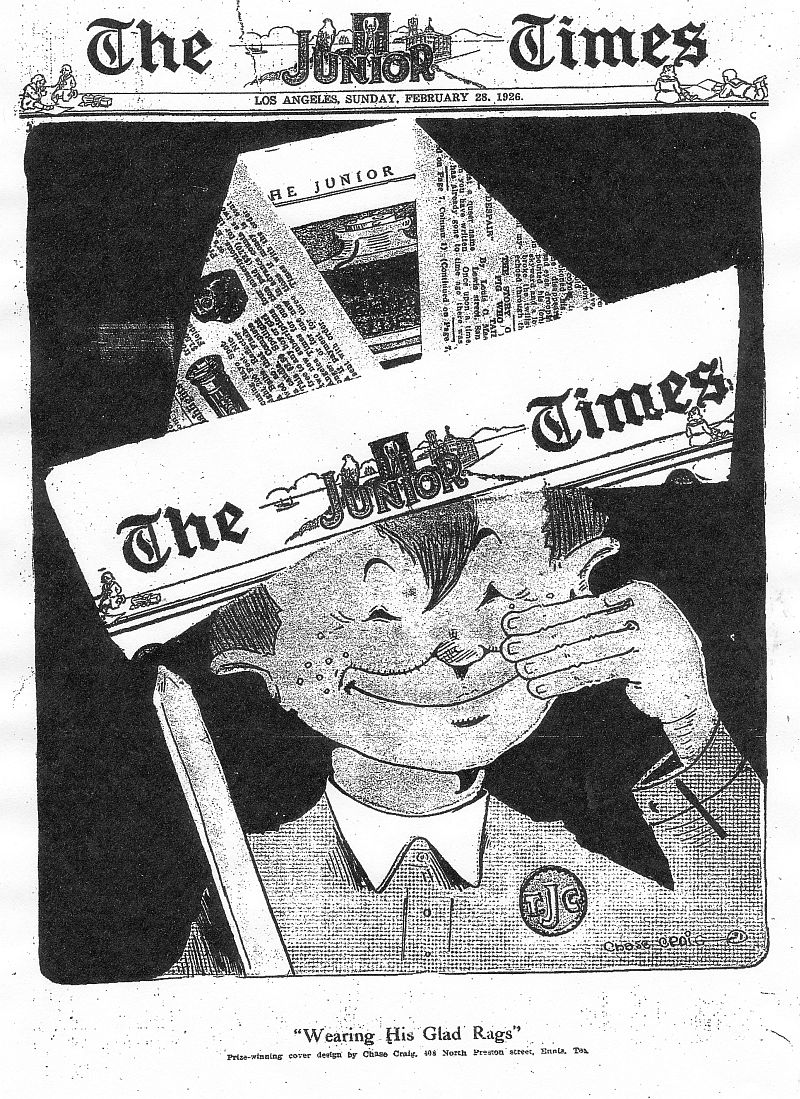






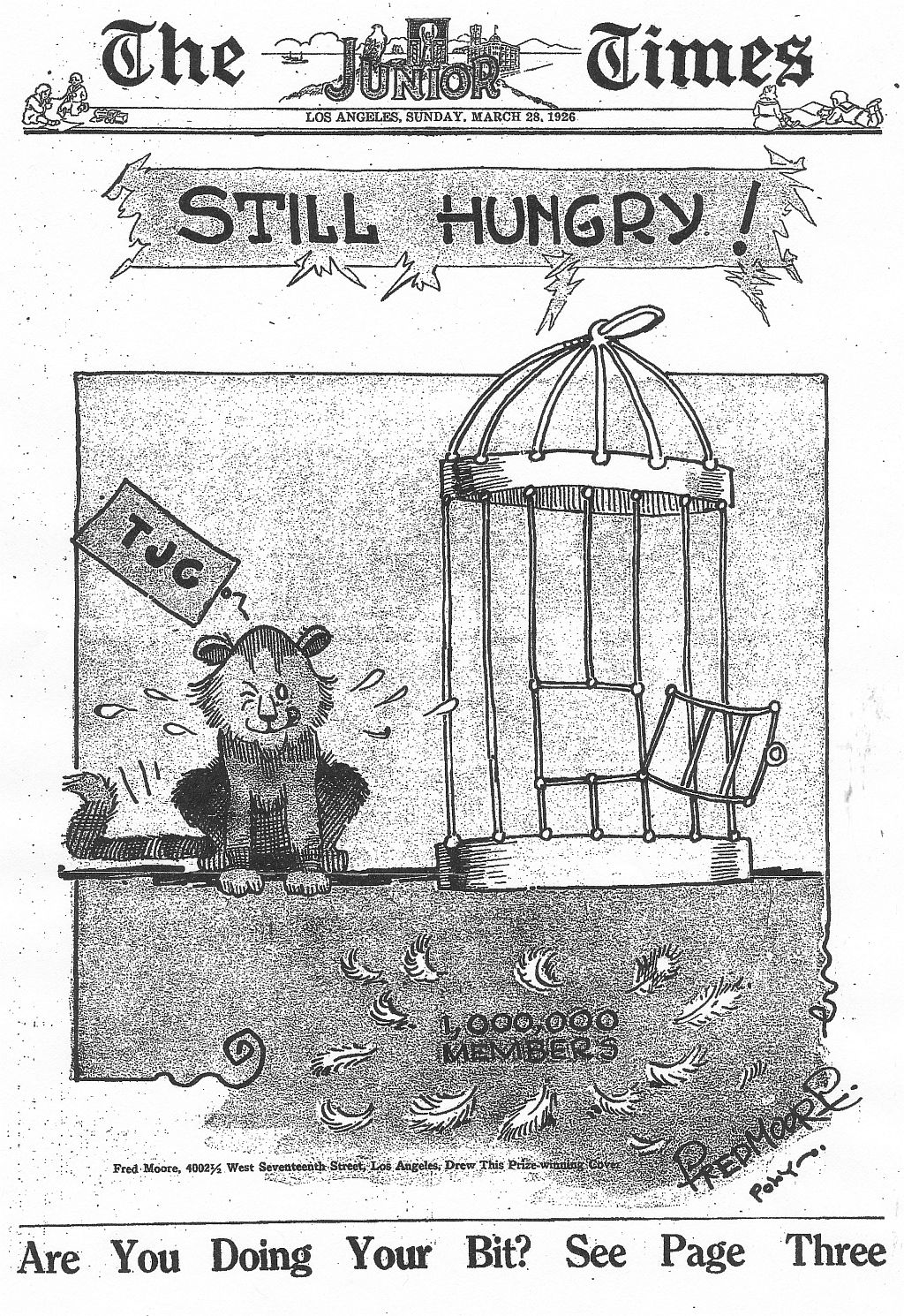  Man, these blogs are just a lot of damned hard work sometimes! This thing is running away with itself, but I just love these old strips and the early work of famous animators, so here we go again with the L.A. Junior Times from 1926! There’s a cover up there from Feb. 28th, 1926, by the pioneering comics editor and cartoonist, Chase Craig! I like the collage he brings to the design, like no other cover designer I’ve seen so far. He received the grand total of ten dollars for his design, large money for a kid in 1926. There are two “Al Falfa” strips by Chase from Feb. 14th, 1926 and an “Archy Jr.” strip by Chase’s pal, Al Perez. Al puts Chase in his “Archy Jr.” strip and makes fun of the “Al Falfa” character. I wonder if Chase knew about FARMER Al Falfa? I love these strips not so much for the jokes, which are strictly Capt. Billy material, but for all the comaraderie and high energy in the Junior Times strips. Note also that Chase had his own fanzine he published from his home in Texas called “Cartoonist and Illustrator”. I have never seen an issue of that ‘zine, have you? For a real jolt of L.A. history, check out “Bobbie’s Clown” from March 7th, 1926 by Bobby Richards. The Clown and his pal visit the Chaplin studio over on La Brea as Charlie films “The Circus”. The first panel is quite authentic, that’s the way the entrance to the studio really looked. I’ve also posted three Fred Moore cartoons, two strips, from Feb. 28th and March 21st, and another 10 dollar cover design, from March 28th, 1926. I don’t quite know what Fred was trying to imply here, did the Times Junior Club eat up it’s members? Even at this early stage of his life, Fred Moore liked cute, appealing characters, and his little cat on the Jr. Times cover is very cute. Fred drew a lot of little kid gags in his comics, these two look like they were stolen from an old Gus Edwards stage routine. Weren’t these kid cartoonists lucky back in ’26 to have Aunt Dolly of the L.A. Times? She really cared about the kids and promoted their work every way that she could. She threw lavish parties for them downtown with guests like Hoot Gibson and Tom Mix, full jazz band orchestras and all the food the kids could eat! More about the Times Junior Club cartoonists next post.
 Man, these blogs are just a lot of damned hard work sometimes! This thing is running away with itself, but I just love these old strips and the early work of famous animators, so here we go again with the L.A. Junior Times from 1926! There’s a cover up there from Feb. 28th, 1926, by the pioneering comics editor and cartoonist, Chase Craig! I like the collage he brings to the design, like no other cover designer I’ve seen so far. He received the grand total of ten dollars for his design, large money for a kid in 1926. There are two “Al Falfa” strips by Chase from Feb. 14th, 1926 and an “Archy Jr.” strip by Chase’s pal, Al Perez. Al puts Chase in his “Archy Jr.” strip and makes fun of the “Al Falfa” character. I wonder if Chase knew about FARMER Al Falfa? I love these strips not so much for the jokes, which are strictly Capt. Billy material, but for all the comaraderie and high energy in the Junior Times strips. Note also that Chase had his own fanzine he published from his home in Texas called “Cartoonist and Illustrator”. I have never seen an issue of that ‘zine, have you? For a real jolt of L.A. history, check out “Bobbie’s Clown” from March 7th, 1926 by Bobby Richards. The Clown and his pal visit the Chaplin studio over on La Brea as Charlie films “The Circus”. The first panel is quite authentic, that’s the way the entrance to the studio really looked. I’ve also posted three Fred Moore cartoons, two strips, from Feb. 28th and March 21st, and another 10 dollar cover design, from March 28th, 1926. I don’t quite know what Fred was trying to imply here, did the Times Junior Club eat up it’s members? Even at this early stage of his life, Fred Moore liked cute, appealing characters, and his little cat on the Jr. Times cover is very cute. Fred drew a lot of little kid gags in his comics, these two look like they were stolen from an old Gus Edwards stage routine. Weren’t these kid cartoonists lucky back in ’26 to have Aunt Dolly of the L.A. Times? She really cared about the kids and promoted their work every way that she could. She threw lavish parties for them downtown with guests like Hoot Gibson and Tom Mix, full jazz band orchestras and all the food the kids could eat! More about the Times Junior Club cartoonists next post.











 Here’s Barker Bill, from 4/18 to 4/30/1955. The Hippo is in big trouble as she swallows a watch with a radium dial. The midget buys a Geiger counter from Col. Whetwhistle and finds that the Hippo is radioactive! A bunch of gangsters kidnap the Hippo to mine the uranium out of her (they think). Puddy and Barker Bill trail the Hippo to the gangsters’ hide-out. The strip from 4/28 is very blurry on the copy I have here (from the Boston Globe). Here’s the dialog: Gangster: “Another juvenile delinquent, disgustin–” Moll: “Leave the poor kid alone and get goin–” Gangster: “Here goes Moll with her mudderly instincts again–” Moll: (to midget) “Diddums baddums man hittums itty bitty darling–” Midget (thinking): “Humiliatin’–But I better play along–” Puddy (to Bill):”Hey–this gives me a hot idea, Bill–Bzzz–” Puddy figures out a pretty painful way for them to escape.
Here’s Barker Bill, from 4/18 to 4/30/1955. The Hippo is in big trouble as she swallows a watch with a radium dial. The midget buys a Geiger counter from Col. Whetwhistle and finds that the Hippo is radioactive! A bunch of gangsters kidnap the Hippo to mine the uranium out of her (they think). Puddy and Barker Bill trail the Hippo to the gangsters’ hide-out. The strip from 4/28 is very blurry on the copy I have here (from the Boston Globe). Here’s the dialog: Gangster: “Another juvenile delinquent, disgustin–” Moll: “Leave the poor kid alone and get goin–” Gangster: “Here goes Moll with her mudderly instincts again–” Moll: (to midget) “Diddums baddums man hittums itty bitty darling–” Midget (thinking): “Humiliatin’–But I better play along–” Puddy (to Bill):”Hey–this gives me a hot idea, Bill–Bzzz–” Puddy figures out a pretty painful way for them to escape.






 Felix from 7-15 to 7-21-1935 has Felix and Danny still on the Ape’s island trying to re-join the Captain’s company. But the Professor’s explorers are cut off from the Captain by a giant Armadillo, who does not suffer cartoon cats gladly. Felix flies up in the air on a giant bird to signal the Captain with cigar smoke sky writing (it’s fun to see Felix smoking), and then temporarily blinds the Armadillo with pepper bombs. Will the Professor cut Felix some slack for these brave deeds? In the Sunday, Felix reforms a robber by giving him a nightmare in which all his body parts are wanted by various dentists and doctors and Indians of Dreamland. The robber is scared straight.
Felix from 7-15 to 7-21-1935 has Felix and Danny still on the Ape’s island trying to re-join the Captain’s company. But the Professor’s explorers are cut off from the Captain by a giant Armadillo, who does not suffer cartoon cats gladly. Felix flies up in the air on a giant bird to signal the Captain with cigar smoke sky writing (it’s fun to see Felix smoking), and then temporarily blinds the Armadillo with pepper bombs. Will the Professor cut Felix some slack for these brave deeds? In the Sunday, Felix reforms a robber by giving him a nightmare in which all his body parts are wanted by various dentists and doctors and Indians of Dreamland. The robber is scared straight.





  In Krazy, from 5-26 to 5-31-1941, there are two phony brick gags, two “chiggen” gags, featuring incubators and an aborted “tryst” turned into a “twist” ending by Ignatz. Herriman continues to suggest a stage setting for the Coconino Kast by popping floorboards and rugs into his foregrounds whenever he can. I especially like the 5-27, with it’s dirt path, cobblestones, floorboards and hedge that falls out of the last panel, while the big tree trunk remains stationary.
 In Krazy, from 5-26 to 5-31-1941, there are two phony brick gags, two “chiggen” gags, featuring incubators and an aborted “tryst” turned into a “twist” ending by Ignatz. Herriman continues to suggest a stage setting for the Coconino Kast by popping floorboards and rugs into his foregrounds whenever he can. I especially like the 5-27, with it’s dirt path, cobblestones, floorboards and hedge that falls out of the last panel, while the big tree trunk remains stationary.
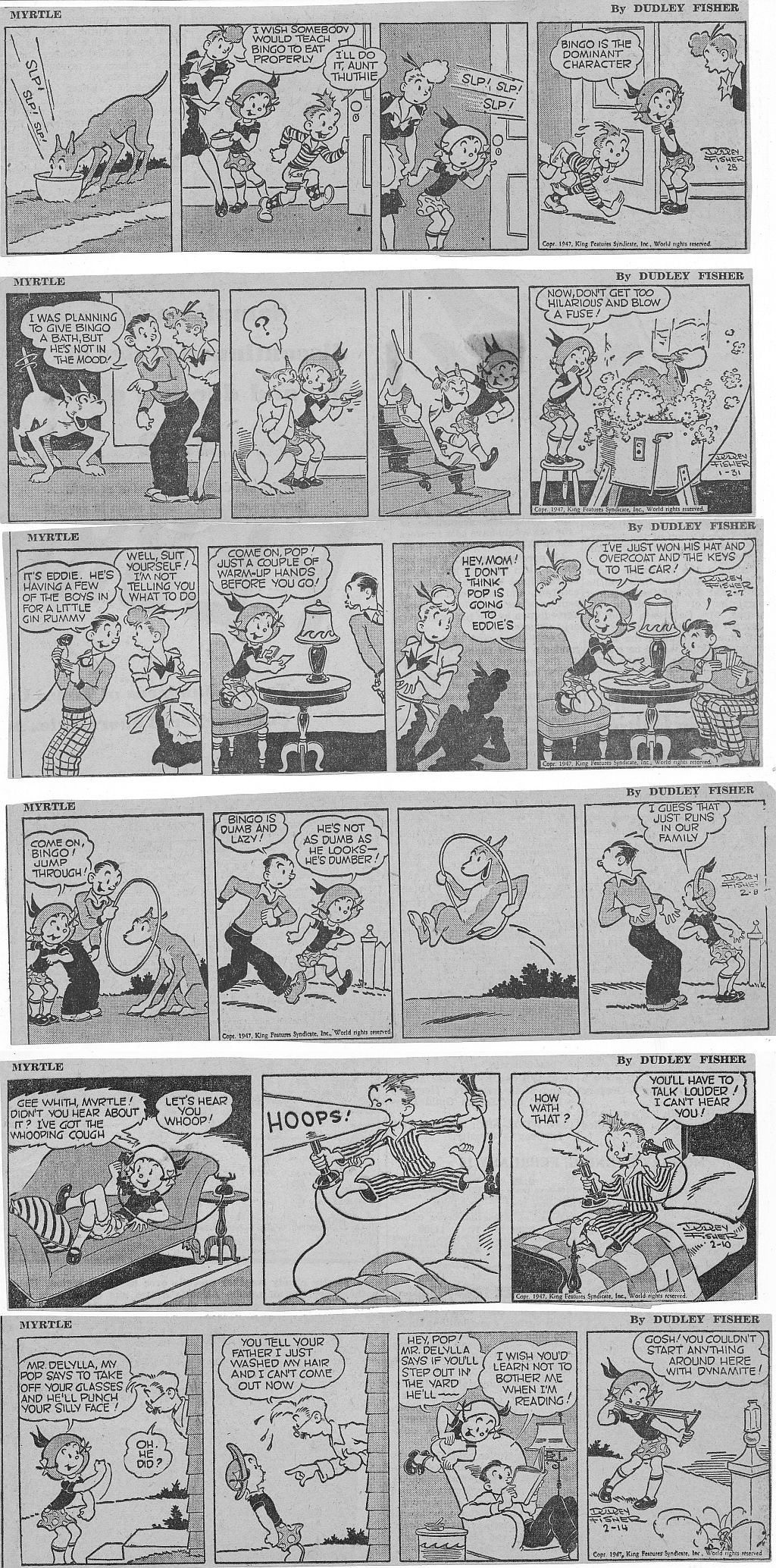  Here’s Myrtle (Right Around Home) by Dudley Fisher, from 1-18 to 2-14-1947. Next post we will get into a more regular sequence with the dates, this time we skip a lot. Bingo the merry dog is featured in the 1-18, 1-31 and 2-8, and Myrtle’s mischievous traits are revealed in the 2-7 (she plays poker better than her Dad) and the 2-14, in which she tries to start a fight between the neighbor and her Dad just for her own amusement. I love the pose that Sampson takes in the second panel of the 2-10 as he gives out with a loud “Whoop”! Fisher’s strips are full of beautiful, flexible character poses and wonderful arrangements of his character groups, with great harmony of design. Most cartoonists today have no concept of a flexible spine in a character, mostly they stand stiff as flagpoles. Composition, character groups? Mostly the same arrangements over and over again.
 Here’s Myrtle (Right Around Home) by Dudley Fisher, from 1-18 to 2-14-1947. Next post we will get into a more regular sequence with the dates, this time we skip a lot. Bingo the merry dog is featured in the 1-18, 1-31 and 2-8, and Myrtle’s mischievous traits are revealed in the 2-7 (she plays poker better than her Dad) and the 2-14, in which she tries to start a fight between the neighbor and her Dad just for her own amusement. I love the pose that Sampson takes in the second panel of the 2-10 as he gives out with a loud “Whoop”! Fisher’s strips are full of beautiful, flexible character poses and wonderful arrangements of his character groups, with great harmony of design. Most cartoonists today have no concept of a flexible spine in a character, mostly they stand stiff as flagpoles. Composition, character groups? Mostly the same arrangements over and over again.



 Â Readers, I’m gonna beat Yowp to the punch. Here’s the May, 1962, Yogi Bear Sunday pages. They are from 5-6 to 5-27. I’m sure he will have good notes on these soon over at his blog, so just keep clicking on “Yowp” over on the Blogroll, and keep tabs on him. I put one over on the old hound this time!
 Readers, I’m gonna beat Yowp to the punch. Here’s the May, 1962, Yogi Bear Sunday pages. They are from 5-6 to 5-27. I’m sure he will have good notes on these soon over at his blog, so just keep clicking on “Yowp” over on the Blogroll, and keep tabs on him. I put one over on the old hound this time!
People, I’m exhausted, but you can catch more craziness on the Cat’s new Facebook page: www.facebook.com/someothercat . There, you will see drawings and a few cel set-ups from the short currently before the cameras, “There Must Be Some Other Cat”. Itza (the Cat’s name) would love to be “Friends” with you over there. Humph, I’ve been doing this blog for five years, where are all my “Friends”!?
Until the next time, Bullet your Heart and Hall Lugea!
Right Around Home!
Do you recognize this wonderful layout style? It’s the 3/4 downshot, one of the most difficult angles to stage action from, done to perfection every week in a Sunday page called “Right Around Home with Myrtle”. This episode was probably drawn by Bob Vittur, but the feature was originated by a cartoonist named Dudley Fisher. Starting this post, the Cat and I will start reprinting some of the daily episodes of the strip, starting Jan. 13, 1947:
I love the character of Little Myrtle, and you’ll get to know her better through these dailies, scanned from newspaper clippings. I’m starting out just posting a few at a time, as the first few weeks of the strip in this collection skip quite a few dates. There IS a little bit of continuity, but it’s mainly the adventures of Myrtle, Freddie and Susie (her parents), Sampson (her lisping boy friend), Slug (her brother), Alice and Archie (the birds in the 1-25 above) and the funny canine characters Bingo and Junior. The Sunday pages mostly “star” the 3/4 staging in one large panel, but the dailies are more intimate, and Myrtle’s tomboy, energetic personality comes to the fore. I like the way Fisher uses Myrtle’s hat as a “bubble” around her face, you can’t tell it’s much of a hat until she turns profile, but that’s part of the abstraction in Fisher’s cartooning. Like Patrick from 1967, Myrtle is a disruptive force in her parents’ and neighborhood’s lives. UNlike Patrick, she is never mean or mean-spirited, just a lot of fun. The characters in “Right Around Home” know they are in a comic strip, and comment occasionally to the reader about that. A lot of people seem to enjoy this comic, hope you will too. The cat character in the strip is named “Hyacinth”, by the way.
Recent finds in the L.A. Jr. Times!
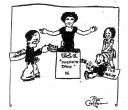 Â Bob Clampett draws Aunt Dolly, 12-6-25
 Bob Clampett draws Aunt Dolly, 12-6-25
 Â
  The first two Fred Moore comics from the Junior Times, 1-17 and 2-7-1926. The last panel in the 1-27 is illegible.
The first two Fred Moore comics from the Junior Times, 1-17 and 2-7-1926. The last panel in the 1-27 is illegible.
 Â
 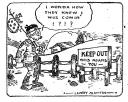 The earliest Larry Martin comics, from 11-15-25, he called himself “Buster” in the first one.
The earliest Larry Martin comics, from 11-15-25, he called himself “Buster” in the first one.
 Â Cartoonist Alex Perez makes Chase Craig into one of his characters, 2-7-26.
 Cartoonist Alex Perez makes Chase Craig into one of his characters, 2-7-26.
 Â George Manuell 12-13-25,
 George Manuell 12-13-25, 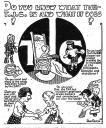  Ray Patin 12-20-25,
 Ray Patin 12-20-25,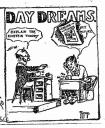  Frank Tipper (?) 11-8-25
 Frank Tipper (?) 11-8-25  Manuel Moreno doing a parody of the 1925 hit: “Doodle Doo Doo” as a salute to the Times Junior Club, 12-27-25. It just gets better as it goes along folks! Too many interesting comics to post!
 Manuel Moreno doing a parody of the 1925 hit: “Doodle Doo Doo” as a salute to the Times Junior Club, 12-27-25. It just gets better as it goes along folks! Too many interesting comics to post!













 Â In Barker Bill this time, from 4-4 to 4-17-1955, the Cold War moves in on the story. Russian Spies Dripsky and Bugovitch want to cop Col. Whetwhistle’s Boo-Boo Tonic to disguise themselves as plants to be placed in Washington D.C. hotel lobbies. That way, they can overhear state secrets! Barker Bill and Puddy are on the job, though, and foil the spie’s plot. Puddy is made an honorary member of the K-9 Corps for his service. The supply of Barker Bill Sundays just about dries up this time, in the 4-10, Puddy is scratched up by a lot of alley cats, and in the 4-17, Puddy tries to eat a dinosaur skeleton.
 In Barker Bill this time, from 4-4 to 4-17-1955, the Cold War moves in on the story. Russian Spies Dripsky and Bugovitch want to cop Col. Whetwhistle’s Boo-Boo Tonic to disguise themselves as plants to be placed in Washington D.C. hotel lobbies. That way, they can overhear state secrets! Barker Bill and Puddy are on the job, though, and foil the spie’s plot. Puddy is made an honorary member of the K-9 Corps for his service. The supply of Barker Bill Sundays just about dries up this time, in the 4-10, Puddy is scratched up by a lot of alley cats, and in the 4-17, Puddy tries to eat a dinosaur skeleton.






 Â In Felix, from 7-8 to 7-14-1935, the serpent vine story continues as Danny escapes and saves Felix. Felix is given credit for the discovery of the vine by the Professor, but in the 7-11, Felix could care less about his discovery, he just cares about his recovery. A sailor who is an expert wrestler tackles the vine next. In the Sunday, Felix again plays God from Dreamland heaven as he changes the life of Tommy, the little lier by giving him a fantastic nightmare. I like the panel where the God-Devil Felix lies in wait for Tommy with a Candy Box containing a vicious leopard!
 In Felix, from 7-8 to 7-14-1935, the serpent vine story continues as Danny escapes and saves Felix. Felix is given credit for the discovery of the vine by the Professor, but in the 7-11, Felix could care less about his discovery, he just cares about his recovery. A sailor who is an expert wrestler tackles the vine next. In the Sunday, Felix again plays God from Dreamland heaven as he changes the life of Tommy, the little lier by giving him a fantastic nightmare. I like the panel where the God-Devil Felix lies in wait for Tommy with a Candy Box containing a vicious leopard!





 Â Krazy from 5-19 to 5-24-1941, features the brick, both rubber and clay types. I love the gag in the 5-24 where Mrs. Kwakk-Wakk asks Krazy if he ever gets headaches from all the brick punishment that his cranium takes. Krazy responds by using a barrel to protect his body! What a mahogany head!
 Krazy from 5-19 to 5-24-1941, features the brick, both rubber and clay types. I love the gag in the 5-24 where Mrs. Kwakk-Wakk asks Krazy if he ever gets headaches from all the brick punishment that his cranium takes. Krazy responds by using a barrel to protect his body! What a mahogany head!
Speaking of cats, my cartoon cat, who now has named himself “Itza”, rebelled against me and escaped to Facebook. I don’t feel comfortable on Facebook, I don’t like to be that easily available on the ‘net, it scares me! But Itza is fearless where the Internet is concerned. He’ll still visit here from time to time, but if you want to see him all the time and maybe write to him, go to www.facebook.com/someothercat and you’ll see what the great webmeister Charles Brubaker and Itza cooked up! There are some drawings and cel set-ups from TMBSOC there as well. I really didn’t want to post any links to Facebook, but Itza threatened me with a loaded cactus.
The First Bob Clampett Cartoooons! 1925-L.A. Jr. Times
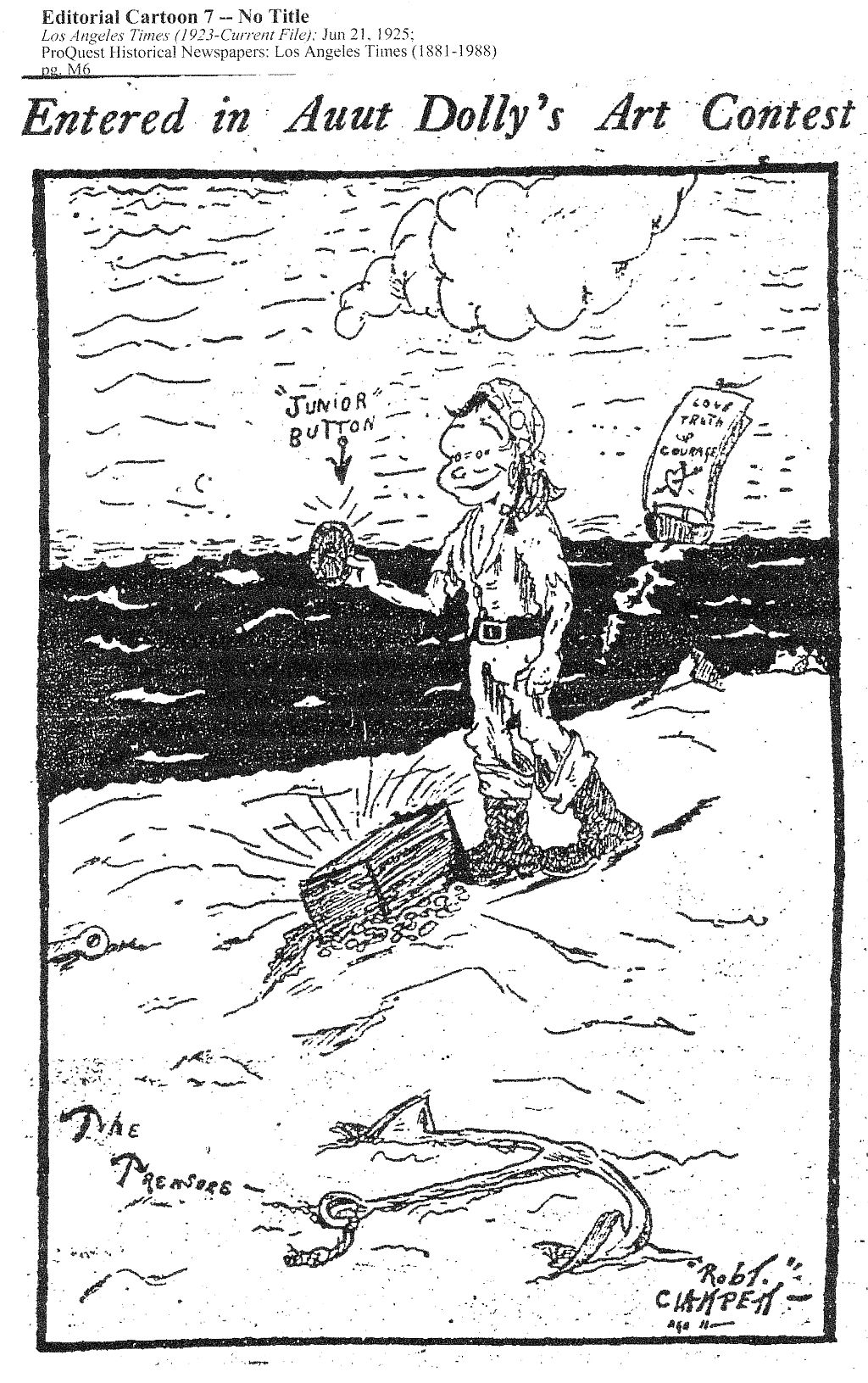 Â In reading the L.A. Junior Times through Proquest, I keep coming across the childhood drawings of famous cartoonists. Now I’ve found the earliest Bob Clampett drawing published in the Junior Times, June 21st, 1925. It appears to be a self-caricature of the young cartoonist as a pirate, finding a Junior Times Club button on a desert island. The drawing is labelled: “The Treasure” and was drawn by Bob at the tender age of eleven! By 1925, the Times Junior Club, or “T.J.C.”, was a thriving org., loved the world over, or at least as far as Chicago, where the The Chicago Tribune, which contributed many features and comic strips to the L.A. Times, Â held sway. They gave cash prizes for original stories, poetry, art and comic strips to the children who sent them in to the Times. They helped poor children, gave big dances at the Times building for all the kids, threw elaborate Christmas parties, and made it a lot of fun just to be a kid. A lady named “Aunt Dolly” was the lynchpin of the T.J.C., and seems to have been well-loved and respected by the aspiring cartoonists and authors in the Junior Times audience.
 In reading the L.A. Junior Times through Proquest, I keep coming across the childhood drawings of famous cartoonists. Now I’ve found the earliest Bob Clampett drawing published in the Junior Times, June 21st, 1925. It appears to be a self-caricature of the young cartoonist as a pirate, finding a Junior Times Club button on a desert island. The drawing is labelled: “The Treasure” and was drawn by Bob at the tender age of eleven! By 1925, the Times Junior Club, or “T.J.C.”, was a thriving org., loved the world over, or at least as far as Chicago, where the The Chicago Tribune, which contributed many features and comic strips to the L.A. Times,  held sway. They gave cash prizes for original stories, poetry, art and comic strips to the children who sent them in to the Times. They helped poor children, gave big dances at the Times building for all the kids, threw elaborate Christmas parties, and made it a lot of fun just to be a kid. A lady named “Aunt Dolly” was the lynchpin of the T.J.C., and seems to have been well-loved and respected by the aspiring cartoonists and authors in the Junior Times audience.
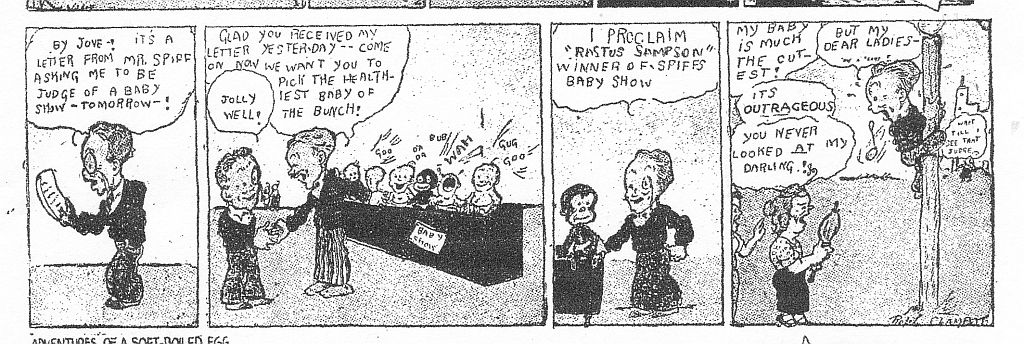 Â This little strip, from June 12th, 1925, is the earliest actual comic that Bob Clampett drew. It’s especially interesting, because at age eleven, Bob already thought that little babies and black characters were funny. The style of art seems patterned after Hardie Gramatky’s, but unlike most of the comics that the Junior Times published, Bob is trying to do a gag with his strip. It’s interesting how the little black baby, “Rastus Sampson”, resembles Bosko, long before Bosko was in production. The timing between the third and fourth panels is also quite sophisticated for an eleven year old kid. The reader can imagine the outrage of the dowagers in the baby contest audience as they chase the British dandy up the telegraph pole. There is some fine print in the Dandy’s dialog balloon that I can’t make out, after “But my dear ladies–“. This strip anticipates the “Black Beauty” gag in “A Coy Decoy”, and of course, “Baby Bottleneck”.
 This little strip, from June 12th, 1925, is the earliest actual comic that Bob Clampett drew. It’s especially interesting, because at age eleven, Bob already thought that little babies and black characters were funny. The style of art seems patterned after Hardie Gramatky’s, but unlike most of the comics that the Junior Times published, Bob is trying to do a gag with his strip. It’s interesting how the little black baby, “Rastus Sampson”, resembles Bosko, long before Bosko was in production. The timing between the third and fourth panels is also quite sophisticated for an eleven year old kid. The reader can imagine the outrage of the dowagers in the baby contest audience as they chase the British dandy up the telegraph pole. There is some fine print in the Dandy’s dialog balloon that I can’t make out, after “But my dear ladies–“. This strip anticipates the “Black Beauty” gag in “A Coy Decoy”, and of course, “Baby Bottleneck”.
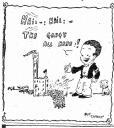
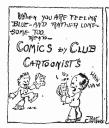
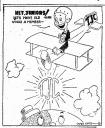 Â These three little panels were published, July 19th, Sept. 25th and June 28th, 1925. The first two are by Bob Clampett, and the third is by Chase Craig, later editor at Western Printing and Lithographing, and Carl Barks’s boss for a while. In the first one, Bob seems to be presenting a typical 1920s Harold Teen type, celebrating with the “gang” near the L.A. Times building downtown, in the second one, Bob is promoting the Junior Times “Comics by Club Cartoonists” page, and Chase Craig is doing the sort of one-world boosterism so typical of the L.A. Times all through the years. The talent latent in these kid cartoonists of the 1920s, continues to impress me. I hope to find more.
 These three little panels were published, July 19th, Sept. 25th and June 28th, 1925. The first two are by Bob Clampett, and the third is by Chase Craig, later editor at Western Printing and Lithographing, and Carl Barks’s boss for a while. In the first one, Bob seems to be presenting a typical 1920s Harold Teen type, celebrating with the “gang” near the L.A. Times building downtown, in the second one, Bob is promoting the Junior Times “Comics by Club Cartoonists” page, and Chase Craig is doing the sort of one-world boosterism so typical of the L.A. Times all through the years. The talent latent in these kid cartoonists of the 1920s, continues to impress me. I hope to find more.











 Â The crazy continuities continue in the Barker Bill strip from 3-21 to 4-2-1955. Puddy the Pup finds the missing Pom-Pom the performing Poodle, and she’s had a litter of pups! Puddy’s laryngitis keeps the suspense going for a while, will he speak in public or not? A new story starts April first, as a medicine showman appears selling “Whetwhistle’s Wonderful Elixir” made from the sap of the Boo-Boo tree. If the customer drinks the elixir, it makes him or her want to chew wood! I’m expecting Woody Woodpecker to get involved in this story somehow!
 The crazy continuities continue in the Barker Bill strip from 3-21 to 4-2-1955. Puddy the Pup finds the missing Pom-Pom the performing Poodle, and she’s had a litter of pups! Puddy’s laryngitis keeps the suspense going for a while, will he speak in public or not? A new story starts April first, as a medicine showman appears selling “Whetwhistle’s Wonderful Elixir” made from the sap of the Boo-Boo tree. If the customer drinks the elixir, it makes him or her want to chew wood! I’m expecting Woody Woodpecker to get involved in this story somehow!






 Â In Felix from 7-1 to 7-7-1935, Felix finds the missing Danny Dooit by trailing the turtle that inadvertently kidnapped the boy. Felix rescues Danny from a rushing river, but both the Cat and the Kid are trapped by the horrible serpent vine in the 7-6. The Sunday page is full of kid antics as Bobby Dazzler trades blows with a bully, and Felix saves a boy from becoming obsessed with firearms, by giving him a bad dream. Winsor McCay continues as ghost-writer for Messmer, (strictly a fabrication).
 In Felix from 7-1 to 7-7-1935, Felix finds the missing Danny Dooit by trailing the turtle that inadvertently kidnapped the boy. Felix rescues Danny from a rushing river, but both the Cat and the Kid are trapped by the horrible serpent vine in the 7-6. The Sunday page is full of kid antics as Bobby Dazzler trades blows with a bully, and Felix saves a boy from becoming obsessed with firearms, by giving him a bad dream. Winsor McCay continues as ghost-writer for Messmer, (strictly a fabrication).





 Â Glass-blowers, “chiggin”s, bread upon the waters and shoeless dogs inhabit the Coconino stage this time, from 5-12 to 5-17-1941. Speaking of stages, the lower third of the Krazy daily in 1941Â is usually taken up by Herriman’s drawings of floorboards, footlights, prompter’s boxes and little staircases, implying that the desert cast is really doing their little gags for the reader on an ever-changing theater stage. As 1940s newspapers continued to crowd daily strips on to a single page, the lower third of the strip was often cut-out to make room. Garge was being creative with that lower third, and using it as a stage was an expendable way to get around comic strip butchery, without sacrificing the gag.
 Glass-blowers, “chiggin”s, bread upon the waters and shoeless dogs inhabit the Coconino stage this time, from 5-12 to 5-17-1941. Speaking of stages, the lower third of the Krazy daily in 1941 is usually taken up by Herriman’s drawings of floorboards, footlights, prompter’s boxes and little staircases, implying that the desert cast is really doing their little gags for the reader on an ever-changing theater stage. As 1940s newspapers continued to crowd daily strips on to a single page, the lower third of the strip was often cut-out to make room. Garge was being creative with that lower third, and using it as a stage was an expendable way to get around comic strip butchery, without sacrificing the gag.
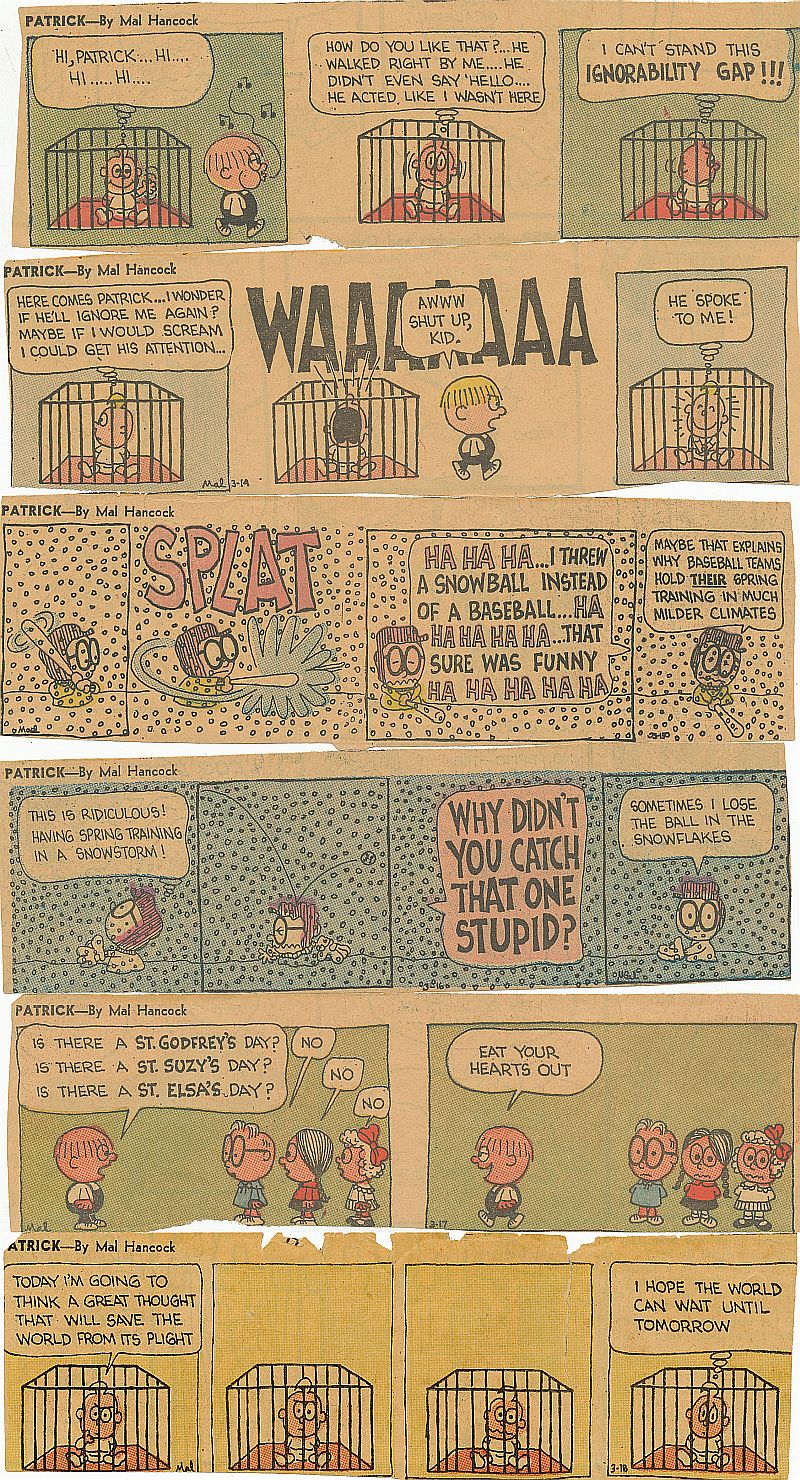 Â Patrick is from 3-13 to 3-18-1967 this time, and we continue to see the rise of Nathan to the starring position. He has three strips mostly to himself. Godfrey also tries to play baseball in a snowstorm, and Patrick thinks that St. Patrick’s day is named for him in the 3-17. Nathan proves ironically prophetic in the 3-18, as he thinks: “I hope the world can wait until tomorrow.” The St. Louis Post-Dispatch did not wait, but dropped “Patrick” after this strip was published. Next time I’ll be presenting another favorite kid strip, many years older than Patrick, by a fine cartoonist.
 Patrick is from 3-13 to 3-18-1967 this time, and we continue to see the rise of Nathan to the starring position. He has three strips mostly to himself. Godfrey also tries to play baseball in a snowstorm, and Patrick thinks that St. Patrick’s day is named for him in the 3-17. Nathan proves ironically prophetic in the 3-18, as he thinks: “I hope the world can wait until tomorrow.” The St. Louis Post-Dispatch did not wait, but dropped “Patrick” after this strip was published. Next time I’ll be presenting another favorite kid strip, many years older than Patrick, by a fine cartoonist.
Yowp has put up black and white, edited versions of these four Yogi Bear Sunday Pages from 4-1, 8, 15 and 22-1962 on his blog. I, as usual, take the bait and post these four clippings from my collection to augment Yowp’s post. I am missing the strip from 4-29, you’ll have to visit Yowp’s blog to see it, just click the link over to the right side of the page. By the way, don’t forget to click the small images to enlarge them.
A big tip of the Cat’s whiskers to Margo Burns of New Hampshire, who purchased a cel from Sc. 22 of “It’s ‘The Cat'”. You should have your cel and complimentary DVD of the cartoon by now, Margo. These cels are still a grand bargain, my readers, for the list price, you get free shipping, a free copy of the DVD, and the cel and (usually) the pencil drawing from which it was traced! It’s almost as good a deal as a membership in the Times Junior Club! Just go to https://itsthecat.com/Gallery-FilmArt.htm and find a cel that you like. Our new production can use the donation, and you will get a beautiful cel from the first cartoon that Greg Ford and I produced. If you want to contribute to our Paypal account, like our friend Bill Warren so generously did, just go to kausler@att.net over on Paypal, and contribute anything you can spare. If you contribute at least $200.00, you will receive screen credit on TMBSOC. Thanks, and keep reading!!
Special 5th Anniversary Post!!
Today, March 27th, 2012, I’m celebrating five years of writing and editing a “blog”. As a special contribution, GREG FORD, my producer on the short cartoon: “There Must Be Some Other Cat”, has sent the first 100 feet of color shots! When I started the CATBLOG, I had no idea which direction it would take, and I knew next to nothing about computers. If truth be told, I had a very strong aversion to the Demon Machines. I didn’t even know how to resize photos and art work so that they could be “published”. I still don’t know how to do a lot of stuff, never got microsoft word or photoshop, but I have word perfect and irfanview, both are free programs and do what I require.
I started out kinda high falutin’, publishing photos of places that Cathy and I have visited for painting trips. Soon, cartoons and comic strips crept into the mix, and now it’s about 90% comic strips. I can’t really make a good defense of reprinting old comic strips, it’s just that I love so many of them, and I’m trying to help them to be remembered. I tried to do a feature for a while where I read DOROTHY PARKER and some of my favorite children’s lit. aloud, but I’m not a great reader, and I got very little response. Again, too high-falutin’.
The CATBLOG was really supposed to be a production journal of the motion picture cartoon: “There Must Be Some Other Cat”, or TMBSOC for short. However, due to fate, TMBSOC and “The Cat” and especially my good friend and producer Greg Ford, have gone through 5 years of hard times and privation. Greg and “The Cat” have lived through a horrible economic crash, the death of cel animation (due in part to these here demon computers), a devastating apartment fire that Greg and his girlfriend Ronnie Schieb managed to survive, the bankruptcy of Kodak and the looming end of all types of photographic film (again, thanks to the demon machines) and now, health problems have affected Ronnie’s life and consequently, Greg’s life (not due to the demon machines). Through all this and more, TMBSOC proceeded at a Snail-Cat’s pace for the last 5 years in the Manhattan jungles. As you can see by the above frame grabs, “The Cat” is beginning to emerge. The scenes really look beautiful projected on 35mm FILM, and I’m so grateful that Greg and many stalwart artists still cared enough to put their best efforts into what seemed like a doomed enterprise.
This Blog has chronicled the passing of many loved ones, friends (Vincent Davis, John Bohnenberger), family (my mother), and animals (Crispy, Little Grey). It has made new friends for me, and regretfully lost some. One of the most popular posts was the article about my visit to Ollie Johnston’s house after he had moved in with his family in Oregon.
(“Here’s the Pitch” Department) Dear Readers, if you can, please buy a cel from “It’s ‘The Cat'” over at https://itsthecat.com/Gallery-FilmArt.htm. If you don’t like the prices, make an offer! We’ll be glad to listen. Also, if you care to contribute any production money directly to “There Must Be Some Other Cat”, you may PayPal it to us at: kausler@att.net or just write to me at: Mark Kausler, 1632 Loma Crest, Glendale, Ca. 91205-3710. Any contribution over $200.00 will get you a screen credit as an “Ailurophile” (Cat lover). Now is the time! The cameras are actually rolling and we need your help. Thanks so much!











 Â In Barker Bill this time, from 3-7 to 3-19-1955, there is a daily missing, 3-8, and a Sunday out, 3-20. It’s easy to follow the conclusion of the Gelt’s story without the 3-8, the Gelt turns out to be a “hen” and lays an egg. In the story starting on 3-16, Puddy falls in love with the new Circus star, Pompom the poodle. In order to impress her, Puddy decides to speak in public for the first time, and perform “Paul Revere”.
 In Barker Bill this time, from 3-7 to 3-19-1955, there is a daily missing, 3-8, and a Sunday out, 3-20. It’s easy to follow the conclusion of the Gelt’s story without the 3-8, the Gelt turns out to be a “hen” and lays an egg. In the story starting on 3-16, Puddy falls in love with the new Circus star, Pompom the poodle. In order to impress her, Puddy decides to speak in public for the first time, and perform “Paul Revere”.



 Â
 

 In Felix, from 6-24 to 6-30-1935, Felix and the Professor’s party search for the missing Danny Dooit, and Felix accidentally discovers a rare cannibal plant. In the Sunday, Messmer continues the attractive 9 panel layout from last week. I love the giant Dream Control machine in the second panel, and the silhouette of the little boy against flame in panel five.
In Felix, from 6-24 to 6-30-1935, Felix and the Professor’s party search for the missing Danny Dooit, and Felix accidentally discovers a rare cannibal plant. In the Sunday, Messmer continues the attractive 9 panel layout from last week. I love the giant Dream Control machine in the second panel, and the silhouette of the little boy against flame in panel five.





  In Krazy this time, from 5-5 to 5-10-1941, gag-a-day continues. I love the crocodile design in the 5-5, Krazy knows that the croc is crying because he’s ugly, and diplomatically says so in the last panel.
 In Krazy this time, from 5-5 to 5-10-1941, gag-a-day continues. I love the crocodile design in the 5-5, Krazy knows that the croc is crying because he’s ugly, and diplomatically says so in the last panel.
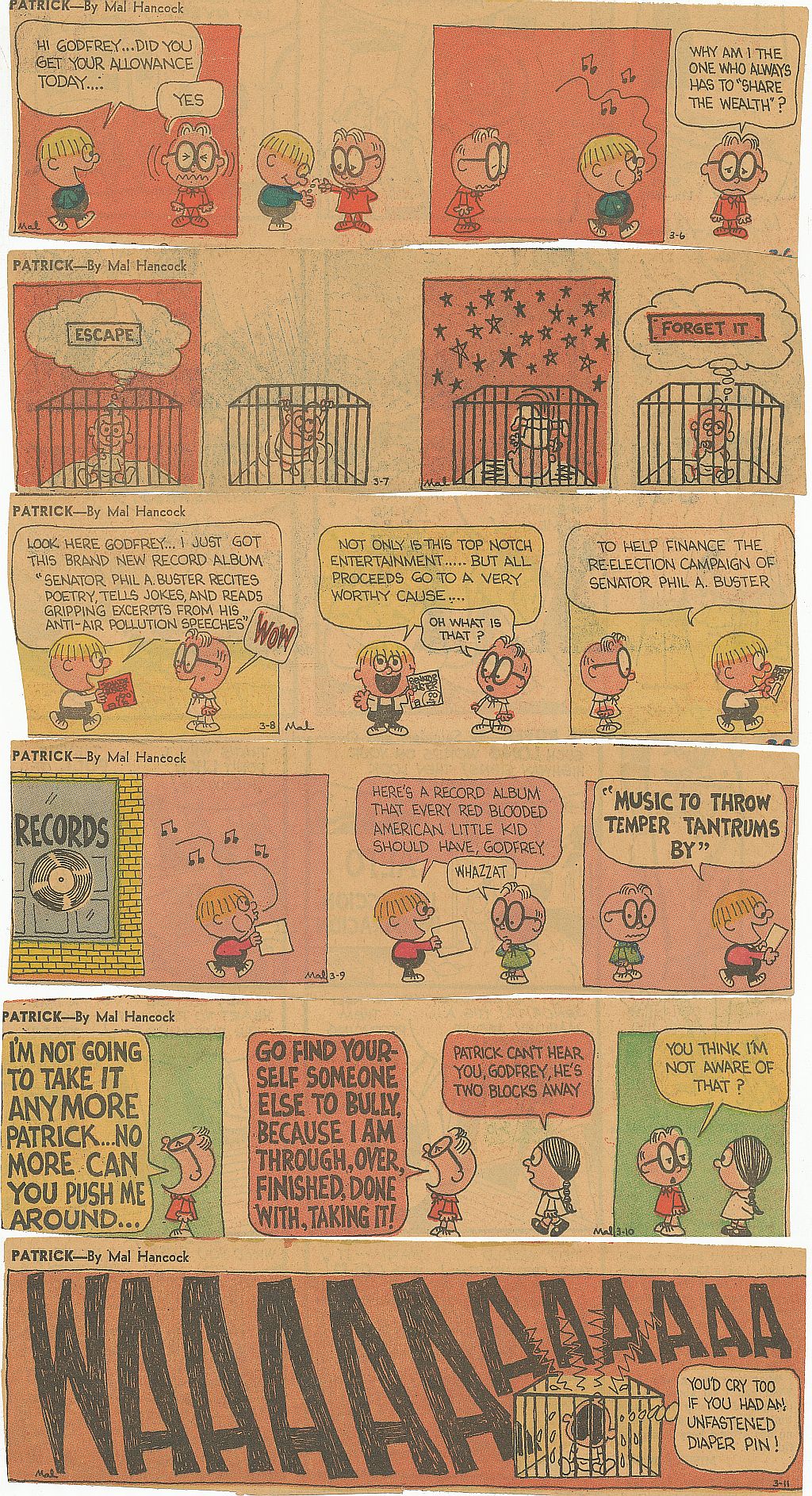 Â In Patrick, from 3-6 to 3-11-1967, Nathan stars in two strips, and Patrick and Godfrey dominate the action the rest of the week. In the 3-8, Patrick works in a little political satire, commenting on the campaign fund-raising efforts of Senator Phil A. Buster. I’ll bet that Patrick would have taken great delight in today’s Super PACs! Remember to click on all the above images to enlarge the strips. By the way, who knows how long the archives to this blog will exist, so if you like the strips, download and save them for yourself! We have the complete Felix strips from 1936 in here, the almost complete “Marvelous Mike” strip, and quite a chunk of “Patrick”, amongst other rareties. Do yourself a favor, save them or lose them!
 In Patrick, from 3-6 to 3-11-1967, Nathan stars in two strips, and Patrick and Godfrey dominate the action the rest of the week. In the 3-8, Patrick works in a little political satire, commenting on the campaign fund-raising efforts of Senator Phil A. Buster. I’ll bet that Patrick would have taken great delight in today’s Super PACs! Remember to click on all the above images to enlarge the strips. By the way, who knows how long the archives to this blog will exist, so if you like the strips, download and save them for yourself! We have the complete Felix strips from 1936 in here, the almost complete “Marvelous Mike” strip, and quite a chunk of “Patrick”, amongst other rareties. Do yourself a favor, save them or lose them!
I had such a long rant today, that it crowded out the L.A. Jr. Times comics, to be continued in the next post.Â
Gramatky and Moreno, L.A. Times Junior Cartoonists!





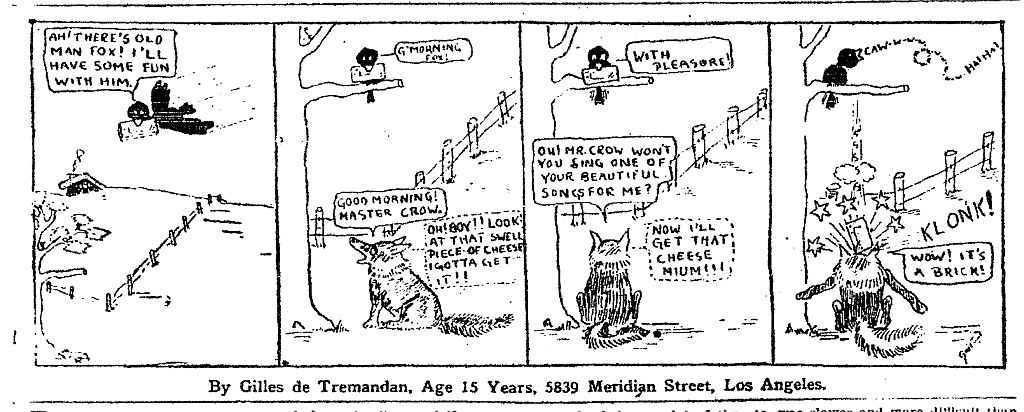 Â We lead off again this time with more strips from the 1924 L.A. Junior Times. Hardie Gramatky and Manuel Moreno produced more work than any of the other kids and managed to get something in almost every issue of the Junior Times. They were paid the whopping sum of $2.50 for every drawing published. Hardie started a feature called “Captain Kidd” in the 9/7/24 issue. From the outset, Hardie has a lot of maturity in his cartoon style, the way he arranges panels reminds me of Roy Crane’s “Wash Tubbs”. Hardie also drew the cover of the 7-13-24 issue, which starts our post this time. Manuel Moreno continued with two comic strip series, The Boy with the Answers, and “The Tuttlems”, which seems to be his version of “The Bungle Family”. I love the characters ‘plopping’ out of the panels on the punch lines. The dates of Moreno’s strips are, respectively, 7/20, 7/27, 8/3, 8/10 and 8/17/1924. As a coda, I’ve included an early strip by Gilles de Tremandan, an Aesop Fable gag featuring the Fox and Crow, published 8/31/1924. Gilles was 15 when he drew this, by the early 1930s he was animating at Disney under the name “Frenchy” (on the drafts, anyway). The old timers always said that they “drew better” than the young whippersnappers, but if you study the childhood drawings of the first wave of old master animators, their drawings look mostly untrained and immature. They learned a great deal in a short time, thanks to the intensive atmosphere of the Disney studio.
 We lead off again this time with more strips from the 1924 L.A. Junior Times. Hardie Gramatky and Manuel Moreno produced more work than any of the other kids and managed to get something in almost every issue of the Junior Times. They were paid the whopping sum of $2.50 for every drawing published. Hardie started a feature called “Captain Kidd” in the 9/7/24 issue. From the outset, Hardie has a lot of maturity in his cartoon style, the way he arranges panels reminds me of Roy Crane’s “Wash Tubbs”. Hardie also drew the cover of the 7-13-24 issue, which starts our post this time. Manuel Moreno continued with two comic strip series, The Boy with the Answers, and “The Tuttlems”, which seems to be his version of “The Bungle Family”. I love the characters ‘plopping’ out of the panels on the punch lines. The dates of Moreno’s strips are, respectively, 7/20, 7/27, 8/3, 8/10 and 8/17/1924. As a coda, I’ve included an early strip by Gilles de Tremandan, an Aesop Fable gag featuring the Fox and Crow, published 8/31/1924. Gilles was 15 when he drew this, by the early 1930s he was animating at Disney under the name “Frenchy” (on the drafts, anyway). The old timers always said that they “drew better” than the young whippersnappers, but if you study the childhood drawings of the first wave of old master animators, their drawings look mostly untrained and immature. They learned a great deal in a short time, thanks to the intensive atmosphere of the Disney studio.













 Barker Bill is from 2-21 to 3-6-1955 this time. Dog Biscuit the horse gets a new pair of glasses and gets circus ambitions almost right away. They discourage the stage struck horse by encouraging the fat lady to ride Dog Biscuit bareback! The Gelt re-enters the story line as a Treasury Man shows up to question Bill about the expense of feeding the money-eating critter. In the Sundays, Gertie the Hippo in the 2-27, resembles the proud lineage of Terrytoons hippopotami, especially in her egg-hatching pose in the last panel. Little May is in the 3-6, as the Circus Problem Child once more. The strips here come from Winnipeg and Boston, hope you enjoy them.
Barker Bill is from 2-21 to 3-6-1955 this time. Dog Biscuit the horse gets a new pair of glasses and gets circus ambitions almost right away. They discourage the stage struck horse by encouraging the fat lady to ride Dog Biscuit bareback! The Gelt re-enters the story line as a Treasury Man shows up to question Bill about the expense of feeding the money-eating critter. In the Sundays, Gertie the Hippo in the 2-27, resembles the proud lineage of Terrytoons hippopotami, especially in her egg-hatching pose in the last panel. Little May is in the 3-6, as the Circus Problem Child once more. The strips here come from Winnipeg and Boston, hope you enjoy them.






 Â Felix is from 6-17 to 6-23-1935, and continues the mad adventures of Danny Dooit and the crew on the Ape’s Island. The giant Duck from last week is here again, still with the walky-talky in his tummy. The island parrots pick up his repeated “Hellos” and broadcast them all over the place, frustrating the old explorer. About this time, Laura is replaced as the top feature on the Sunday page by “Bobby Dazzler”, a ‘Skippy’ like small boy, designed by Otto Messmer. The parrot gag in the dailies almost seems like a farewell to Laura parrot jokes, but it’s probably just a coincidence.
 Felix is from 6-17 to 6-23-1935, and continues the mad adventures of Danny Dooit and the crew on the Ape’s Island. The giant Duck from last week is here again, still with the walky-talky in his tummy. The island parrots pick up his repeated “Hellos” and broadcast them all over the place, frustrating the old explorer. About this time, Laura is replaced as the top feature on the Sunday page by “Bobby Dazzler”, a ‘Skippy’ like small boy, designed by Otto Messmer. The parrot gag in the dailies almost seems like a farewell to Laura parrot jokes, but it’s probably just a coincidence.





 Â Krazy, from 4-28 to 5-3-1941, is quite shocking! All the gags deal with cats’ fur being a good conductor of electricity, until Offissa Pupp figures out how to electrify Ignatz’s brick to discourage him from throwing it. I love Pupp’s understatement in the 5-2, “I expect him to drop it.”
 Krazy, from 4-28 to 5-3-1941, is quite shocking! All the gags deal with cats’ fur being a good conductor of electricity, until Offissa Pupp figures out how to electrify Ignatz’s brick to discourage him from throwing it. I love Pupp’s understatement in the 5-2, “I expect him to drop it.”
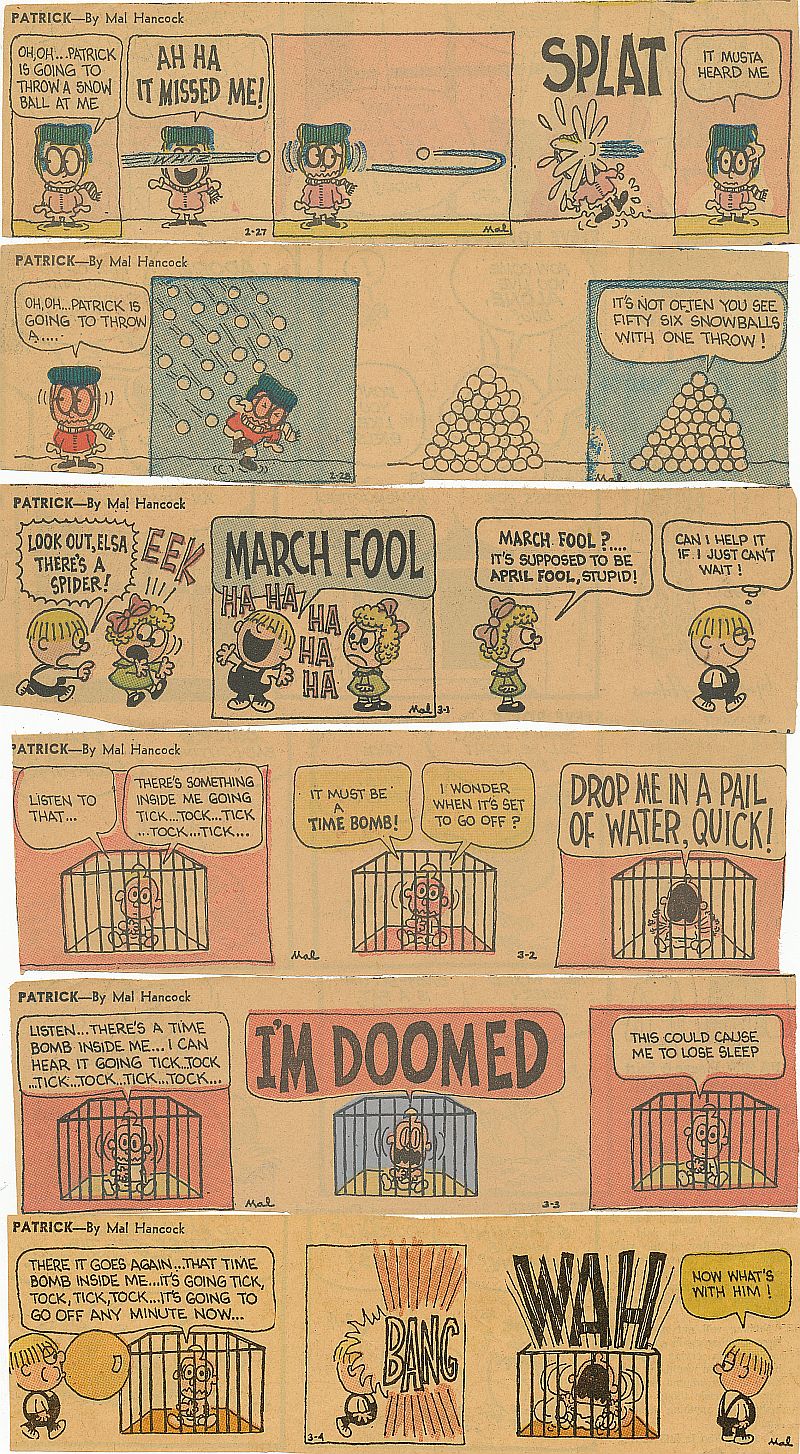 Patrick, from 2-27 to 3-4-1967, features gags with Godfrey, Elsa and Nathan. Nathan has half the strips, from 3-2 to 3-4, in which he is slowly going mad. Poor Nathan thinks there is a time bomb inside of him, and you can see the result of his hallucination in the 3-4. The strip is slowly starting to shift it’s focus to Nathan, perhaps Hancock found a baby confined in a playpen to be stimulating to his imagination. By the way, I’ll run out of Patrick strips in two more posts, but I have something rare to take his place. The next post should pop up on the 27th, the fifth anniversary of this foolish enterprise called a blog. We started March 27th, 2007. See you then!
Patrick, from 2-27 to 3-4-1967, features gags with Godfrey, Elsa and Nathan. Nathan has half the strips, from 3-2 to 3-4, in which he is slowly going mad. Poor Nathan thinks there is a time bomb inside of him, and you can see the result of his hallucination in the 3-4. The strip is slowly starting to shift it’s focus to Nathan, perhaps Hancock found a baby confined in a playpen to be stimulating to his imagination. By the way, I’ll run out of Patrick strips in two more posts, but I have something rare to take his place. The next post should pop up on the 27th, the fifth anniversary of this foolish enterprise called a blog. We started March 27th, 2007. See you then!
The Junior Times Marches On!
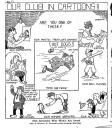

 Â Continuing our new series on the L.A. Junior Times from 1924, I found a Hardie Gramatky front page drawing called “Knight-Life on the Ark” published 3-16-1924. About 9 years later, in March of 1933, Hardie was animating on “Father Noah’s Ark” in Ben Sharpsteen’s unit at Walt Disney Productions, so here he was predicting his own future! Manuel Moreno was so well thought of by “Aunt Dolly” of the Junior Times Club, that he became the “official” club cartoonist! I’ve run three of his more interesting drawings from the 1924 Jr. Times, “Our Club in Cartoons” from June 22, dutifully promotes all the divisions of the Club, writing, cartooning, baseball, acting, humane works and member recruiting. What a club that must have been! Manuel did a lot of different drawings for the Jr. Times, some showing pretty girls in flowery outfits, some showing an idealized Aunt Dolly (leader of the Club), and then his own comic strips. I ran a couple of “Mr. Peach” pages last post, here is the first strip of an irregular series called “The Tuttlems” that ran 7-66-1924, and an episode of the series, “The Boy Who Wants To Know”, from 7-13-1924. The latter strip uses a very old joke that must go back to 1889, still in use as late as ’24. I’ll post more of these as I come across them.
 Continuing our new series on the L.A. Junior Times from 1924, I found a Hardie Gramatky front page drawing called “Knight-Life on the Ark” published 3-16-1924. About 9 years later, in March of 1933, Hardie was animating on “Father Noah’s Ark” in Ben Sharpsteen’s unit at Walt Disney Productions, so here he was predicting his own future! Manuel Moreno was so well thought of by “Aunt Dolly” of the Junior Times Club, that he became the “official” club cartoonist! I’ve run three of his more interesting drawings from the 1924 Jr. Times, “Our Club in Cartoons” from June 22, dutifully promotes all the divisions of the Club, writing, cartooning, baseball, acting, humane works and member recruiting. What a club that must have been! Manuel did a lot of different drawings for the Jr. Times, some showing pretty girls in flowery outfits, some showing an idealized Aunt Dolly (leader of the Club), and then his own comic strips. I ran a couple of “Mr. Peach” pages last post, here is the first strip of an irregular series called “The Tuttlems” that ran 7-66-1924, and an episode of the series, “The Boy Who Wants To Know”, from 7-13-1924. The latter strip uses a very old joke that must go back to 1889, still in use as late as ’24. I’ll post more of these as I come across them.













  In Barker Bill, from 2-7 to 2-20-1955, Peanuts Perkins’ mistake in mixing up costumes, leads Gorgonzola the Circus Gorilla to don Barker Bill’s extra tuxedo. The Boombar Gang catches Gorgonzola and believes him to be Barker Bill by the cut of his clothes and hat. Hatchet Head, one of the Gang’s minions, wants to run “Bill/Gorgonzola” for Mayor, believing the Gorilla can be easily controlled by the Boombars. Puddy, however, being the brains of the Circus, lures Gorgonzola back to the Circus using a beautiful Girl Gorilla for bait. In the Sunday page from 2-20, Puddy sings a little of “Beautiful You”, a song composed by Phil Scheib for the Terrytoon: “An Igloo For Two”, released in 1955, same year these strips were published. It’s interesting that Bob Kuwahara, who drew the Barker Bill strip, and Hardie Gramatky both animated on “Father Noah’s Ark” at Disney in 1933. Another animator in the Sharpsteen unit on “Father Noah’s Ark”, Tom Bonfiglio, was my first boss in animation in St. Louis when I was a kid. He trained me to do inbetweens and gave me cels in exchange for my “work”. He had changed his name to Tom Goodson by then. It’s interesting how everything hooks up eventually. Tom told me that the animators on “Father Noah’s Ark” were promised bonuses and other favors if they would work a lot of extra hours to finish all the “crowd” scenes with the Ark animals. All that they received for the moonlighting was fifty cents for a hash-house dinner, the bonuses never materialized.
 In Barker Bill, from 2-7 to 2-20-1955, Peanuts Perkins’ mistake in mixing up costumes, leads Gorgonzola the Circus Gorilla to don Barker Bill’s extra tuxedo. The Boombar Gang catches Gorgonzola and believes him to be Barker Bill by the cut of his clothes and hat. Hatchet Head, one of the Gang’s minions, wants to run “Bill/Gorgonzola” for Mayor, believing the Gorilla can be easily controlled by the Boombars. Puddy, however, being the brains of the Circus, lures Gorgonzola back to the Circus using a beautiful Girl Gorilla for bait. In the Sunday page from 2-20, Puddy sings a little of “Beautiful You”, a song composed by Phil Scheib for the Terrytoon: “An Igloo For Two”, released in 1955, same year these strips were published. It’s interesting that Bob Kuwahara, who drew the Barker Bill strip, and Hardie Gramatky both animated on “Father Noah’s Ark” at Disney in 1933. Another animator in the Sharpsteen unit on “Father Noah’s Ark”, Tom Bonfiglio, was my first boss in animation in St. Louis when I was a kid. He trained me to do inbetweens and gave me cels in exchange for my “work”. He had changed his name to Tom Goodson by then. It’s interesting how everything hooks up eventually. Tom told me that the animators on “Father Noah’s Ark” were promised bonuses and other favors if they would work a lot of extra hours to finish all the “crowd” scenes with the Ark animals. All that they received for the moonlighting was fifty cents for a hash-house dinner, the bonuses never materialized.






 Â In Felix, from 6-10 to 6-16-1935, Felix and the ship’s crew spend a week on the Ape’s Island being confused by a giant duck that swallowed the Captain’s two-way radio transmitter. The duck becomes terrified of the radio in his tummy and flies all over the island, mixing everybody up. In the Sunday page, Felix lures the subconscious mind of a skilled carpenter to Dreamland, to build a house for the elves, and we bid farewell to Laura, the first Felix “topper”. She concludes her 1927 to 1935 run by cussing a blue streak! Maybe that’s why she was fired?
 In Felix, from 6-10 to 6-16-1935, Felix and the ship’s crew spend a week on the Ape’s Island being confused by a giant duck that swallowed the Captain’s two-way radio transmitter. The duck becomes terrified of the radio in his tummy and flies all over the island, mixing everybody up. In the Sunday page, Felix lures the subconscious mind of a skilled carpenter to Dreamland, to build a house for the elves, and we bid farewell to Laura, the first Felix “topper”. She concludes her 1927 to 1935 run by cussing a blue streak! Maybe that’s why she was fired?





 A good six strip continuity is in Krazy this time, from 4-21 to 4-26-1941. Ignatz and Krazy take turns scaring each other with really zany masks that only Garge could draw. In the 4-26, Ignatz turns his talents to scaring a pachyderm; love those Herriman elephants!
A good six strip continuity is in Krazy this time, from 4-21 to 4-26-1941. Ignatz and Krazy take turns scaring each other with really zany masks that only Garge could draw. In the 4-26, Ignatz turns his talents to scaring a pachyderm; love those Herriman elephants!
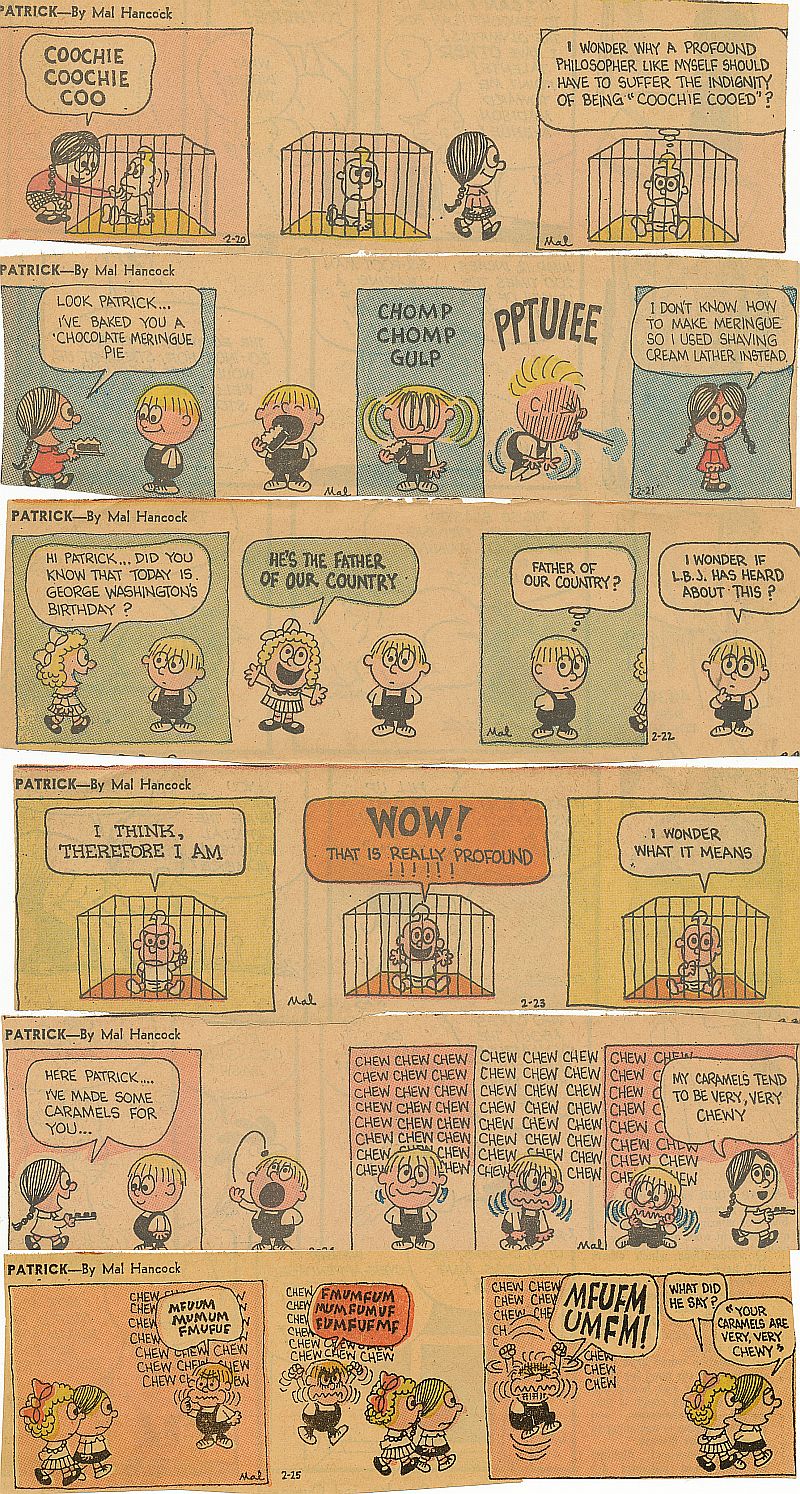 Â In Patrick, from 2-20 to 2-25-1967, little brother Nathan has the starring part in two strips, and Suzy’s meringue pie and “very chewy” caramels drive Patrick nuts! In the 2-22, a Washington’s birthday strip, Patrick refers to “L.B.J.”. To those of you who weren’t around then, that’s Lyndon Baines Johnson, President from 1963 to 1969, Patrick’s President!
 In Patrick, from 2-20 to 2-25-1967, little brother Nathan has the starring part in two strips, and Suzy’s meringue pie and “very chewy” caramels drive Patrick nuts! In the 2-22, a Washington’s birthday strip, Patrick refers to “L.B.J.”. To those of you who weren’t around then, that’s Lyndon Baines Johnson, President from 1963 to 1969, Patrick’s President!



 Â You know, if it weren’t for Yowp’s blog (see link to your right), I couldn’t start posting each month. The black and white Yogi Sunday pages he posts, spur me on to put up the color half-page versions. These ran 3/4, 3/11, 3/18 and 3/25/1962, and feature the work of Harvey Eisenberg (also an animator on “Father Noah’s Ark”-Just Kidding!), and others. I had some good news on “There Must Be Some Other Cat” this week, I’ll tell you more about it when I get some more definite info. Until the next time, when, possibly you all will tune in again…
 You know, if it weren’t for Yowp’s blog (see link to your right), I couldn’t start posting each month. The black and white Yogi Sunday pages he posts, spur me on to put up the color half-page versions. These ran 3/4, 3/11, 3/18 and 3/25/1962, and feature the work of Harvey Eisenberg (also an animator on “Father Noah’s Ark”-Just Kidding!), and others. I had some good news on “There Must Be Some Other Cat” this week, I’ll tell you more about it when I get some more definite info. Until the next time, when, possibly you all will tune in again…
Introducing the The Junior Times from 1922-1923!
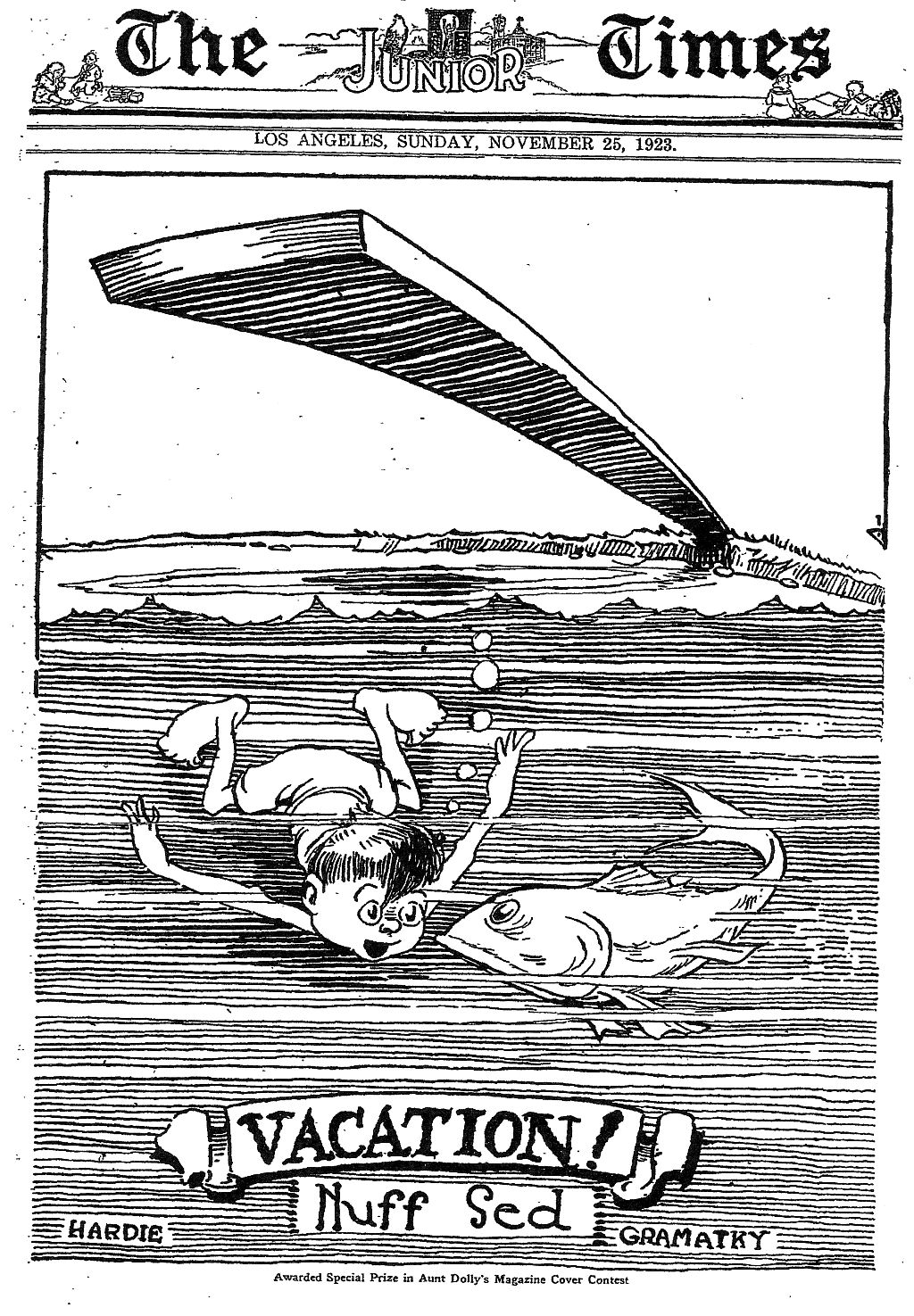 There isn’t much information around the ‘net about “The Junior Times”, the 8 page little tabloid Sunday supplement for children, started as a supplement to the Los Angeles Sunday Times on July 23, 1922. Here is the announcement of the little paper, advertised on the front page of the Los Angeles Times:
There isn’t much information around the ‘net about “The Junior Times”, the 8 page little tabloid Sunday supplement for children, started as a supplement to the Los Angeles Sunday Times on July 23, 1922. Here is the announcement of the little paper, advertised on the front page of the Los Angeles Times: 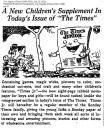  The paper started out a lot like a miniature “St. Nicholas” magazine, reprinting some of the Chicago Tribune’s kid-skewing features like “The Teeny-Weenies” and obscure comic strips like “Just Dog” by Robert Dickey and “Buttons and Fatty” by a cartoonist named “Meb”. It wasn’t until Sept. 9th, 1923 that “Aunt Dolly”‘s interactive pages for children started. The mysterious Aunt encouraged poetry, fiction, art and photography from her young readers and got a good response. Among the earliest contributors were Manuel M. Moreno, who was an animation pioneer working with Walter Lantz as early as 1930:
 The paper started out a lot like a miniature “St. Nicholas” magazine, reprinting some of the Chicago Tribune’s kid-skewing features like “The Teeny-Weenies” and obscure comic strips like “Just Dog” by Robert Dickey and “Buttons and Fatty” by a cartoonist named “Meb”. It wasn’t until Sept. 9th, 1923 that “Aunt Dolly”‘s interactive pages for children started. The mysterious Aunt encouraged poetry, fiction, art and photography from her young readers and got a good response. Among the earliest contributors were Manuel M. Moreno, who was an animation pioneer working with Walter Lantz as early as 1930: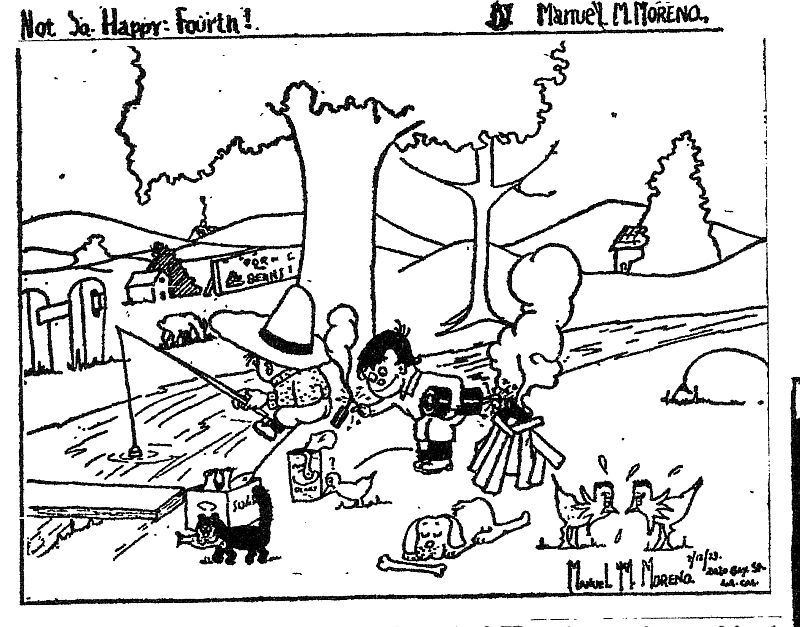 This little drawing, “Not So Happy Fourth” from 9-9-1923, is the earliest one I could find in the Jr. Times. Manuel developed a cuter Oswald the Rabbit for Walter Lantz while he worked there, he had a more appealing and controlled approach to his animation than the usual standard at Lantz. As a child, he figured prominently in the 1923 Aunt Dolly Christmas Party: “Speaking of Toy-Makers reminds me of the good news concerning our talented cartoonist, Manuel K. (sic) Moreno. He is making a meteorlike career for himself. First capturing a Kodak as a prize, then receiving a special $5 cash prize in addition for exceptional Toy-Maker work. But not content with such honors, he has become a captain of our famous club, thereby winning another prize. Now just when Aunt Dolly was writing his order for a $2.50 check, in he has come with two bulging parcels under his arm. ‘For the Toy-Makers,’ he said, with his ready smile, ‘I hope they will make some little boy and girl happy.’ It is needless to say that The Times committee of happiness was surprised when they looked down on his clever pivoting toys, a cat that humps his back, raises it’s tail and rolls it’s eyes at you, a football player carved and painted, that throws a ball like a bluestreak, and a clown that opens his mouth and makes grimaces at you.” (by Aunt Dolly, 12-2-1923) Note the early penchant for animation in Moreno’s early toys! I certainly wish I could see pictures of those toys, especially the cat! Here are two episodes of Manuel’s early comic strip for the Jr. Times, called “Mr. Peach”:
This little drawing, “Not So Happy Fourth” from 9-9-1923, is the earliest one I could find in the Jr. Times. Manuel developed a cuter Oswald the Rabbit for Walter Lantz while he worked there, he had a more appealing and controlled approach to his animation than the usual standard at Lantz. As a child, he figured prominently in the 1923 Aunt Dolly Christmas Party: “Speaking of Toy-Makers reminds me of the good news concerning our talented cartoonist, Manuel K. (sic)Â Moreno. He is making a meteorlike career for himself. First capturing a Kodak as a prize, then receiving a special $5 cash prize in addition for exceptional Toy-Maker work. But not content with such honors, he has become a captain of our famous club, thereby winning another prize. Now just when Aunt Dolly was writing his order for a $2.50 check, in he has come with two bulging parcels under his arm. ‘For the Toy-Makers,’ he said, with his ready smile, ‘I hope they will make some little boy and girl happy.’ It is needless to say that The Times committee of happiness was surprised when they looked down on his clever pivoting toys, a cat that humps his back, raises it’s tail and rolls it’s eyes at you, a football player carved and painted, that throws a ball like a bluestreak, and a clown that opens his mouth and makes grimaces at you.” (by Aunt Dolly, 12-2-1923) Note the early penchant for animation in Moreno’s early toys! I certainly wish I could see pictures of those toys, especially the cat! Here are two episodes of Manuel’s early comic strip for the Jr. Times, called “Mr. Peach”: 
 Â These are from Oct. and Dec., 1923 and are among the earliest child-contributed comic strips I found in the Jr. Times. I also found an early drawing by Bob Wickersham:
 These are from Oct. and Dec., 1923 and are among the earliest child-contributed comic strips I found in the Jr. Times. I also found an early drawing by Bob Wickersham: 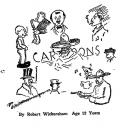  from 9-16-1923, and Cal Howard:
 from 9-16-1923, and Cal Howard:   Nov. 11, 1923. I’m sure both these boys are well-known to animation fans, Wickersham for his animation at Disney’s and Screen Gems, where he was the main contributor to the “Fox and Crow” cartoons, and Cal Howard, animator for Walter Lantz, who became a key gag and story creator in the golden age, contributing stories to Lantz almost right up to 1972. Thanks to the Glendale Library’s subscription to the vintage L.A. Times, I can search the 1920s papers without loading any microfilm into readers, all the material is right here on the ‘net. The “Vacation, ‘Nuff Sed” cover drawing above is by Hardie Gramatky, future creator of “Little Toot” and pioneer Disney animator, as well as one of the finest California watercolorists. He was one of John Bohnenberger’s idols as related in a previous post. Hardie’s mother, and brother Herbert both contributed to Aunt Dolly’s contests as well in 1923. It must have helped Hardie to come from such an artistic family, look what he did with his heritage! I’ll try to find more material from “The Junior Times” as we go along. Such kids as Fred Moore contributed some comics to the Junior Times later on, as we’ll see.
 Nov. 11, 1923. I’m sure both these boys are well-known to animation fans, Wickersham for his animation at Disney’s and Screen Gems, where he was the main contributor to the “Fox and Crow” cartoons, and Cal Howard, animator for Walter Lantz, who became a key gag and story creator in the golden age, contributing stories to Lantz almost right up to 1972. Thanks to the Glendale Library’s subscription to the vintage L.A. Times, I can search the 1920s papers without loading any microfilm into readers, all the material is right here on the ‘net. The “Vacation, ‘Nuff Sed” cover drawing above is by Hardie Gramatky, future creator of “Little Toot” and pioneer Disney animator, as well as one of the finest California watercolorists. He was one of John Bohnenberger’s idols as related in a previous post. Hardie’s mother, and brother Herbert both contributed to Aunt Dolly’s contests as well in 1923. It must have helped Hardie to come from such an artistic family, look what he did with his heritage! I’ll try to find more material from “The Junior Times” as we go along. Such kids as Fred Moore contributed some comics to the Junior Times later on, as we’ll see.












  Barker Bill is from 1-24 to 2-6-1955 this time. The circus is still travelling, with many gags featuring the Fat Lady, Phyllis Fizeek and May, her niece, Elephants, a Giraffe and of course, Peanut Perkins, the resident dumb roustabout. Perkins is even in the Sunday page from the Boston Globe. A mix-up in deliveries to the tailor and the Gorilla by Peanut, set up the next batch of continuity gags in the Barker Bill strip.
 Barker Bill is from 1-24 to 2-6-1955 this time. The circus is still travelling, with many gags featuring the Fat Lady, Phyllis Fizeek and May, her niece, Elephants, a Giraffe and of course, Peanut Perkins, the resident dumb roustabout. Perkins is even in the Sunday page from the Boston Globe. A mix-up in deliveries to the tailor and the Gorilla by Peanut, set up the next batch of continuity gags in the Barker Bill strip.






 Â Felix from 6-3 to 6-9-1935 continues the Gorilla Island story. It’s uncanny how such a cartoony style as Messmer’s can create scary monster animals, such as the ones in 6-6 and 6-8 episodes. The giant duck introduced in the 6-8 figures in the story to a great extent later on. The Giant making a pipe out of an elf’s house in the Sunday page, reminds me of some of the gags in “The Brave Little Tailor”, a Mickey Mouse cartoon from 1938. Messmer did them first!
 Felix from 6-3 to 6-9-1935 continues the Gorilla Island story. It’s uncanny how such a cartoony style as Messmer’s can create scary monster animals, such as the ones in 6-6 and 6-8 episodes. The giant duck introduced in the 6-8 figures in the story to a great extent later on. The Giant making a pipe out of an elf’s house in the Sunday page, reminds me of some of the gags in “The Brave Little Tailor”, a Mickey Mouse cartoon from 1938. Messmer did them first!





 Â Krazy this time is from 4-14 to 4-19-1941. The continuity lasts all week and involves two trees, Offissa Pupp and Ignatz as the principal elements. The last two strips feature a talking brick. The key weapon in the strip has become a character.
 Krazy this time is from 4-14 to 4-19-1941. The continuity lasts all week and involves two trees, Offissa Pupp and Ignatz as the principal elements. The last two strips feature a talking brick. The key weapon in the strip has become a character.
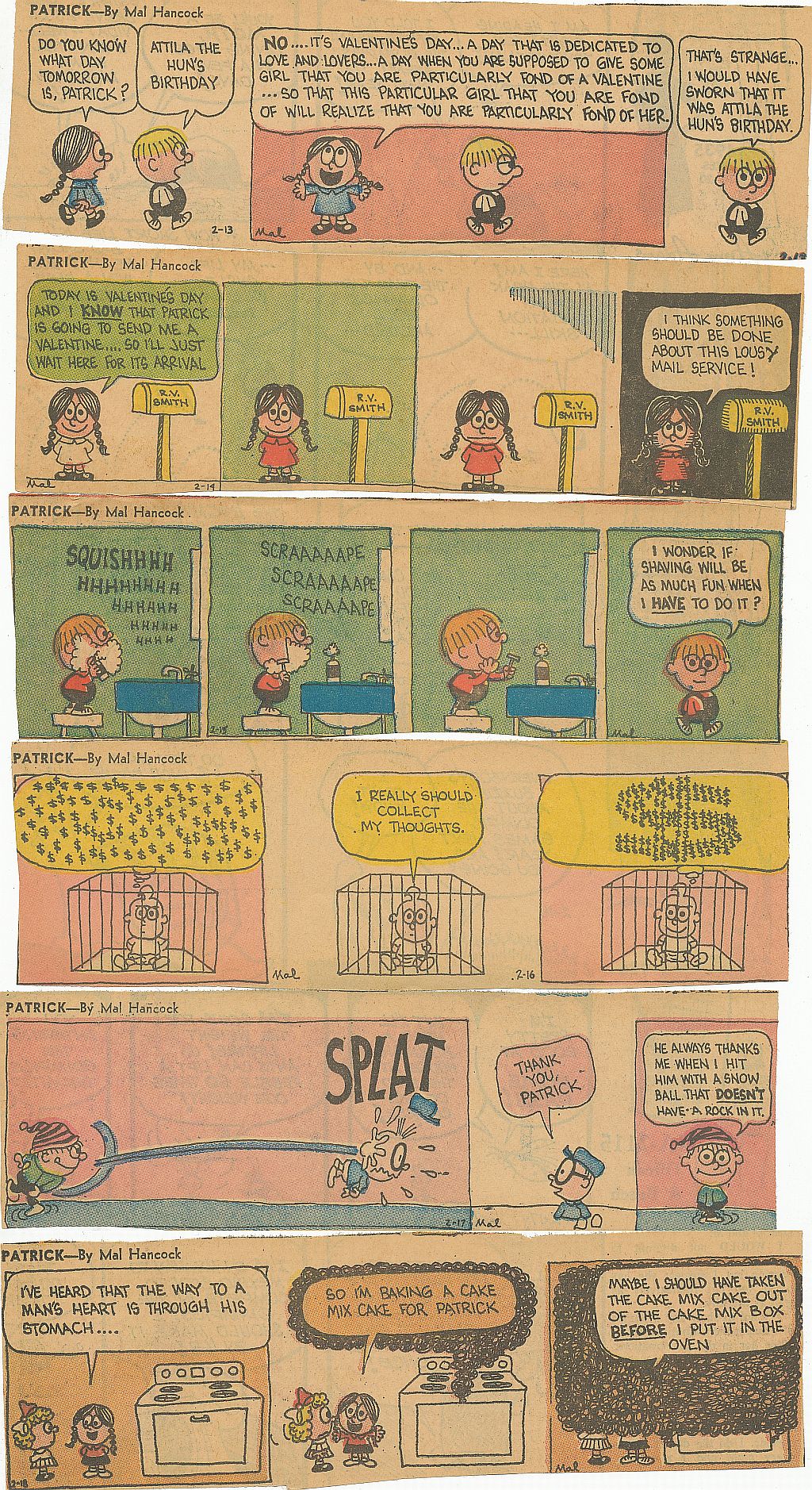 Patrick, from 2-13 to 2-18-1967, concludes our little screed this time. Suzy is the featured supporting player this week, trying to get a valentine out of Patrick and trying to appeal to his stomach with a cake. Patrick believes that St. Valentine’s day is actually Attila the Hun’s birthday. Sounds like an appropriate hero for the horrible little brat.
Patrick, from 2-13 to 2-18-1967, concludes our little screed this time. Suzy is the featured supporting player this week, trying to get a valentine out of Patrick and trying to appeal to his stomach with a cake. Patrick believes that St. Valentine’s day is actually Attila the Hun’s birthday. Sounds like an appropriate hero for the horrible little brat.
If any of you historians out there can contribute some info. to the “Junior Times” series, drop me a line. It will be a welcome relief from all the mail I get in Russian and the strange offers of Faster Computer Speeds which usually originate from Gmail addresses. Cut it out you guys, or I’ll give you such a pinch!
Strips












 Â The response to the John Bohnenberger posts weren’t too much, but that’s understandable. The computer savvy are too young, and the folks who knew John are mostly computer illiterate. I’ll just post some comics this time, starting with Barker Bill from 1-10 to 1-22-1955. The gags all feature the side-show freaks like the tall man, the fat lady and Phyllis Fezeek, the strong woman. Her little niece May figures in some of these. Peanuts Perkins, roustabout and all-around dumb guy is good for a few jokes as well.
 The response to the John Bohnenberger posts weren’t too much, but that’s understandable. The computer savvy are too young, and the folks who knew John are mostly computer illiterate. I’ll just post some comics this time, starting with Barker Bill from 1-10 to 1-22-1955. The gags all feature the side-show freaks like the tall man, the fat lady and Phyllis Fezeek, the strong woman. Her little niece May figures in some of these. Peanuts Perkins, roustabout and all-around dumb guy is good for a few jokes as well.






  I echo the elve’s comment in the last panel of the Felix Sunday page, “What would we do without Felix?” Here’s Felix from 5-27 to 6-2-1935. He’s still on the Ape’s island with Danny and the explorers from the ship. Mostly insect and strange animals populate the tropical paradise in this batch of strips. I love the pose in the last panel of the 6-1, as Felix happily dozes after subduing a horned beast with a brace of melons. I love the change of character in the “Laura” topper, as she becomes less of a pest, and more of a homeless parrot in need of love.
 I echo the elve’s comment in the last panel of the Felix Sunday page, “What would we do without Felix?” Here’s Felix from 5-27 to 6-2-1935. He’s still on the Ape’s island with Danny and the explorers from the ship. Mostly insect and strange animals populate the tropical paradise in this batch of strips. I love the pose in the last panel of the 6-1, as Felix happily dozes after subduing a horned beast with a brace of melons. I love the change of character in the “Laura” topper, as she becomes less of a pest, and more of a homeless parrot in need of love.





 Â Krazy, from 4-7 to 4-12-1941, starts off with an iconic Ignatz strip in which he is “Hunted, Haunted and Hounded” as we all are, by the threat of incarceration. There are also a couple of little two-day continuities featuring Offissa Pupp fishing for Ignatz with a fishing pole baited with brick, and Krazy and Pupp sailing down the river in a box.
 Krazy, from 4-7 to 4-12-1941, starts off with an iconic Ignatz strip in which he is “Hunted, Haunted and Hounded” as we all are, by the threat of incarceration. There are also a couple of little two-day continuities featuring Offissa Pupp fishing for Ignatz with a fishing pole baited with brick, and Krazy and Pupp sailing down the river in a box.
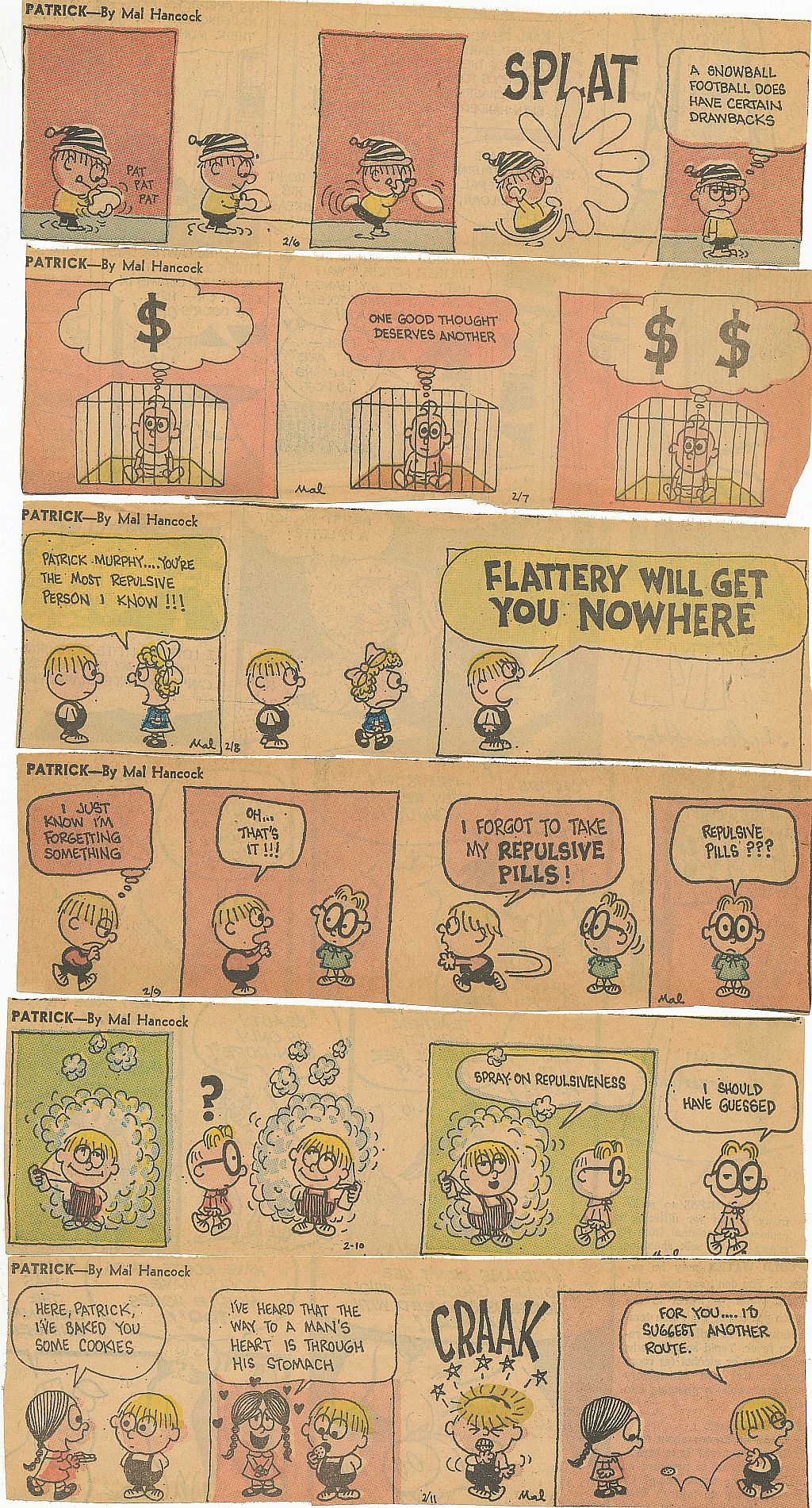  Here’s Patrick, 2-6 to 2-11-1967. Patrick gets his repulsiveness from pills and sprays, and poor Suzy can’t bake her way into Patrick’s very hard heart with her concrete cookies in the 2-11. Well, I’m gonna keep my head down and keep puttin’ up these crazy strips til’ y’all beg for mercy! See you next post.
 Here’s Patrick, 2-6 to 2-11-1967. Patrick gets his repulsiveness from pills and sprays, and poor Suzy can’t bake her way into Patrick’s very hard heart with her concrete cookies in the 2-11. Well, I’m gonna keep my head down and keep puttin’ up these crazy strips til’ y’all beg for mercy! See you next post.
More About John Bohnenberger
Cathy and I are thinking a lot of our late friend, and wonderful artist, John Bohnenberger. Cathy wrote a tribute to him that was in the last post. This time I’m putting up four images of John’s paintings that I found on the Internet that I especially admire. The one upstairs is called “The Fox”, and has to be my favorite Bohnenberger I’ve seen so far. I love the black squiggle he’s used for the little fox at the bottom of the page, and how the small creature seems to be looking out over his purple and yellow pond into the forest beyond. John’s really used complimentary colors well here, and he’s just suggested the forest in the distance by leaving white, pine shaped spaces in the background. Reflections work well in watercolor, and John has used them very appealingly here. I love this painting for it’s color and cartooniness!

  The two paintings here are called “Blue Boy” and “The Intersection”. They show two sides of John’s skill, “Blue Boy” shows his almost photographic style, very realistic handling of the boats with those watercolor reflections dominating the composition. The top half of the picture is loaded with detail, but doesn’t feel heavy. The bottom half is devoted to reflections of the top half, but not a mirror image. John could really do water! “The Intersection” is the more impressionist side of John’s ability. Very loose handling of the people, buildings, umbrellas and sky, coupled with a wet street for those attractive reflections. He’s used little bits of bright color, red accents in the signs and orange in the ponchos, which brighten the whole painting. He’s used violet and subdued colors most everywhere else. This painting suggests a city street without painting every window ledge and headlight.
 The two paintings here are called “Blue Boy” and “The Intersection”. They show two sides of John’s skill, “Blue Boy” shows his almost photographic style, very realistic handling of the boats with those watercolor reflections dominating the composition. The top half of the picture is loaded with detail, but doesn’t feel heavy. The bottom half is devoted to reflections of the top half, but not a mirror image. John could really do water! “The Intersection” is the more impressionist side of John’s ability. Very loose handling of the people, buildings, umbrellas and sky, coupled with a wet street for those attractive reflections. He’s used little bits of bright color, red accents in the signs and orange in the ponchos, which brighten the whole painting. He’s used violet and subdued colors most everywhere else. This painting suggests a city street without painting every window ledge and headlight. 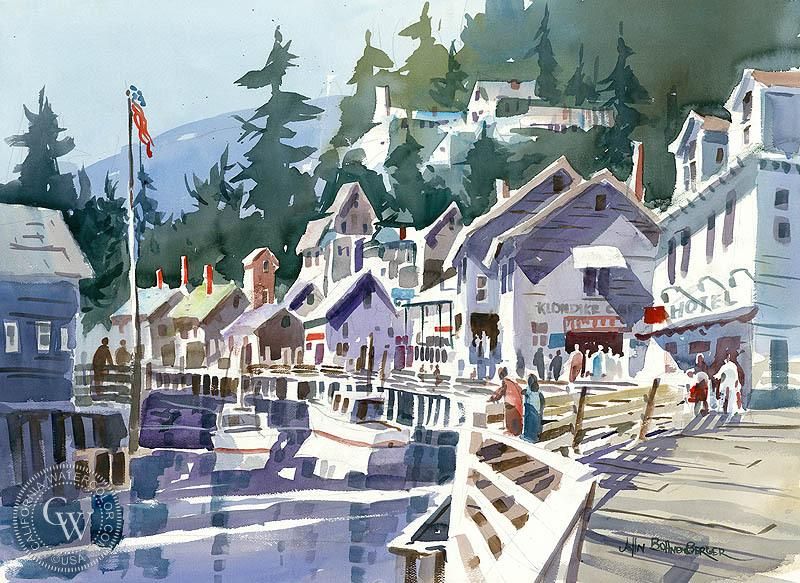  Here is another beautiful watercolor that John called, “The Klondike Cafe”. This painting suggests a little harbor in Alaska without an over-excess of mood. The trees in the background are really one big shape with just a few little accent shapes for contrast and the buildings and boats are defined by the shadows and reflections they cast on themselves and on the water. Note how different the reflections are in this painting than in “Blue Boy”. Very simple white shapes with a few white squiggles on the surface of the water. This painting reminds me of watercolors that might have been done by Roger Armstrong (who John knew) and Hardie Gramatky.
 Here is another beautiful watercolor that John called, “The Klondike Cafe”. This painting suggests a little harbor in Alaska without an over-excess of mood. The trees in the background are really one big shape with just a few little accent shapes for contrast and the buildings and boats are defined by the shadows and reflections they cast on themselves and on the water. Note how different the reflections are in this painting than in “Blue Boy”. Very simple white shapes with a few white squiggles on the surface of the water. This painting reminds me of watercolors that might have been done by Roger Armstrong (who John knew) and Hardie Gramatky.   Here’s a copy of the now “rare” little program printed for John’s eulogy near the retirement community where he lived. John lived to be 86, but always seemed younger than that to us. John, Cathy and I are and were shy people. We don’t like to force ourselves on anybody, and usually keep to ourselves. John didn’t encourage any visitors to his little living space which you can see below from the outside. According to friends, John had no room in his apartment for anyone to sit. It was FILLED floor to ceiling with his paintings. If you visited, you stood until you got tired, then the visit was over. Like visiting Ollie Johnston’s house when he had left it, this same feeling came over me when we saw where John had lived. How I wish we (or I) had just BULLED my way over there and knocked on John’s door. I really wanted to visit his studio. He never invited us (or me) and didn’t encourage visitors, but shucks, this man was very special, and SHOULD have been visited. So, dear, shy and gentle readers, if you admire an artist or want to visit them, just BULL your way in there. Look how short life is, and how little time we have to say “I love your work, how do you do it?” I wish I could have put a little note in John’s mailbox below, saying simply, “John we loved your paintings, and loved you, too.”
 Here’s a copy of the now “rare” little program printed for John’s eulogy near the retirement community where he lived. John lived to be 86, but always seemed younger than that to us. John, Cathy and I are and were shy people. We don’t like to force ourselves on anybody, and usually keep to ourselves. John didn’t encourage any visitors to his little living space which you can see below from the outside. According to friends, John had no room in his apartment for anyone to sit. It was FILLED floor to ceiling with his paintings. If you visited, you stood until you got tired, then the visit was over. Like visiting Ollie Johnston’s house when he had left it, this same feeling came over me when we saw where John had lived. How I wish we (or I) had just BULLED my way over there and knocked on John’s door. I really wanted to visit his studio. He never invited us (or me) and didn’t encourage visitors, but shucks, this man was very special, and SHOULD have been visited. So, dear, shy and gentle readers, if you admire an artist or want to visit them, just BULL your way in there. Look how short life is, and how little time we have to say “I love your work, how do you do it?” I wish I could have put a little note in John’s mailbox below, saying simply, “John we loved your paintings, and loved you, too.”













 Â In Barker Bill, from 12-27-1954 to 1-9-55, the strong woman, Phyllis Fezeek, invites her niece, May to visit her. May immediately starts playing rough with Puddy, who breaks his rule against speaking to anybody but Bill and talks to May. The circus packs up to go on the road, fat lady, efficiency expert and all. In the Sunday for Jan. 9th, there are a couple of gags that remind me of the song “Lydia the Tattooed Lady” from the Marx Bros. film “At The Circus”, and the final panel reminds me of the RBGH that cows are fed these days. Maybe they give the cows green colored glasses so they can’t see the awful stuff they throw in their troughs.
 In Barker Bill, from 12-27-1954 to 1-9-55, the strong woman, Phyllis Fezeek, invites her niece, May to visit her. May immediately starts playing rough with Puddy, who breaks his rule against speaking to anybody but Bill and talks to May. The circus packs up to go on the road, fat lady, efficiency expert and all. In the Sunday for Jan. 9th, there are a couple of gags that remind me of the song “Lydia the Tattooed Lady” from the Marx Bros. film “At The Circus”, and the final panel reminds me of the RBGH that cows are fed these days. Maybe they give the cows green colored glasses so they can’t see the awful stuff they throw in their troughs.






 Â Felix this time, from 5-20 to 5-26-1935, continues the story of the Island Ape held captive on the ship. Felix lures the Ape’s little family on board to keep him company, and ship’s company prepares to explore the island by getting inoculated against jungle fever. In the Sunday, Felix continues to wear white gloves as he uses hollow spaghetti to blow black pepper in the face of the giant.
 Felix this time, from 5-20 to 5-26-1935, continues the story of the Island Ape held captive on the ship. Felix lures the Ape’s little family on board to keep him company, and ship’s company prepares to explore the island by getting inoculated against jungle fever. In the Sunday, Felix continues to wear white gloves as he uses hollow spaghetti to blow black pepper in the face of the giant.





 Â In Krazy, 1-31 to 4-5-1941, a gramophone and a famous Latin phrase bookend the gags. Ignatz gets a black eye from a tough dog character other than Offissa Pupp in the 4-5.
 In Krazy, 1-31 to 4-5-1941, a gramophone and a famous Latin phrase bookend the gags. Ignatz gets a black eye from a tough dog character other than Offissa Pupp in the 4-5.
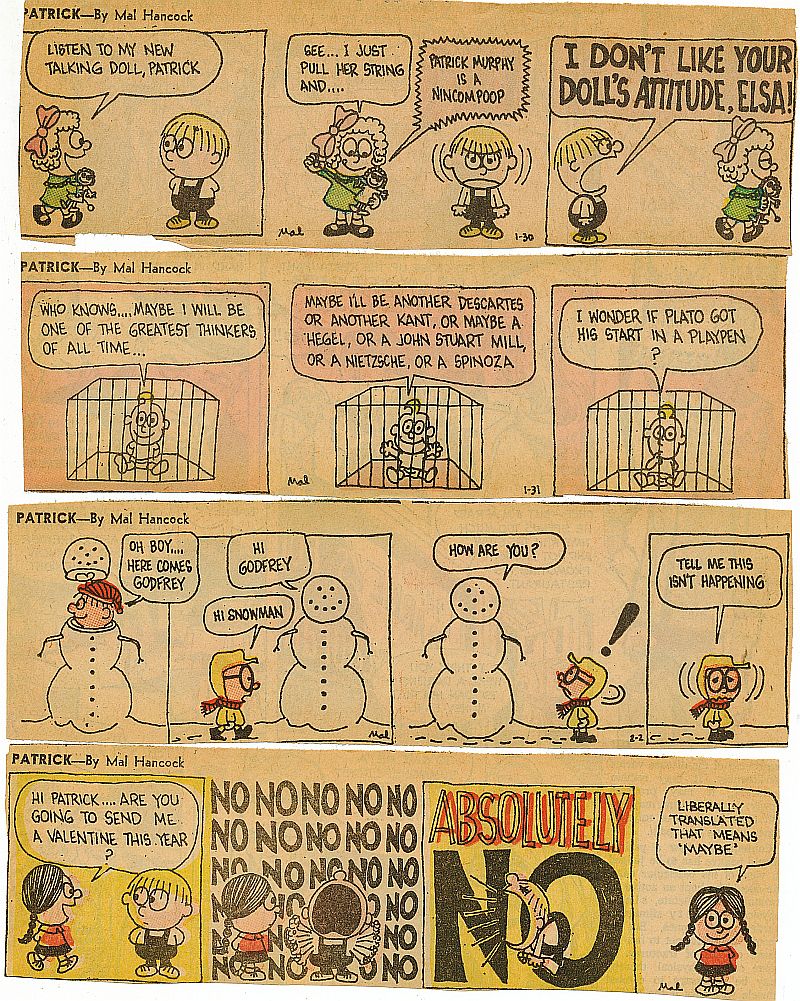 Â Patrick, this time from 1-30 to 2-4-1967, missed two days, 2-1 and 2-3. I guess Dad didn’t bring the paper home those nights. Nathan certainly has command of philosophy in the 1-31. I’m not familiar with John Stuart Mill, guess I’ve got some research to do.
 Patrick, this time from 1-30 to 2-4-1967, missed two days, 2-1 and 2-3. I guess Dad didn’t bring the paper home those nights. Nathan certainly has command of philosophy in the 1-31. I’m not familiar with John Stuart Mill, guess I’ve got some research to do.



 Â Yogi this time, for the month of February, 1962, features four strips which are probably a collaboration between Gene Hazelton and Harvey Eisenberg. The 2-25 really looks like Harvey’s work to me, especially the last panel. The rest of the strips could have been drawn by Hazelton, but the logos look like Harvey’s distinctive letter designs. Make sure you click “Yowp” on the blogroll over to the right, and read what Yowp has to say about these Yogi Bear pages over at his blog. Check out Tralfaz too, always interesting reading. Remember to click all the images above to see them larger and avoid those computer headaches.
 Yogi this time, for the month of February, 1962, features four strips which are probably a collaboration between Gene Hazelton and Harvey Eisenberg. The 2-25 really looks like Harvey’s work to me, especially the last panel. The rest of the strips could have been drawn by Hazelton, but the logos look like Harvey’s distinctive letter designs. Make sure you click “Yowp” on the blogroll over to the right, and read what Yowp has to say about these Yogi Bear pages over at his blog. Check out Tralfaz too, always interesting reading. Remember to click all the images above to see them larger and avoid those computer headaches.
John Bohnenberger, R.I.P.
“John The Magician” by Catherine Hill
John Bohnenberger’s version of “John The Magician”
John’s Divisionist Still-Life
A Rare Written Statement about John by John.
What can you say about such a dear friend and great watercolorist as John Bohnenberger. He left us early in January, but his work will always be here. He belongs with the best California watercolorists, such as Hardie Gramatky, Phil Dyke, Charles Phillipi and Millard Sheets. He studied with Roger Armstrong, a great watercolorist and comic strip artist (assistant to Clifford McBride). The first painting you see up top is Cathy Hill’s oil tribute to John Bohnenberger; “John the Magician”. Our Thursday Morning Irregulars Painting group was painting at the home of Guy Rose, another historic California artist, and Cathy was moved to capture the elusive Mr. John B. at work. He always carried an old video display box with him, notched to hold his drawing board. Here is Cathy’s statement to go along with her painting:
I remember seeing his bold watercolor paintings many years ago. I thought, “Who is this amazing artist?”. Finally, in a San Gabriel Art Association show, someone said, “There’s the great John Bohnenberger”–Where? I looked. There! I saw a thin little guy with a hat. I was impressed. Later I got to know him.
Mark and I painted with John on Thursdays in a plein air group from the San Gabriel Art Association. As the group changed, sometimes John and Mark and I were the only ones to show up. John always said if he went a day without painting, he didn’t feel right. If he was really happy with his painting that day, he would slap it down and say: “Eat your heart out!” We loved it! He must have had enough award ribbons to stitch them together to make 12 quilts! John was an inspirational sight–throwing water wildly from his brushes and using his self-made desk table from a VHS display box that he tied around his legs (for wind defense) and folded into a carrying suitcase. The last time I saw him was at Julie Abreau’s funeral. She was a wonderful person and watercolor artist. She gave rides in her van to John Bohnenberger and Walter Zetlmaier on Thursdays. She called them “my boys”.
John’s work had a bold and sure-of-itself quality, but he was shy about his talent, always avoiding doing demos, and was intimidated by professional artists. But all the professional artists were in awe of him. Painting seemed to come magically and easily to him–even abstract watercolors.
He was truly John the Magician.
I was always begging John for a spot at his watercolor classes, but he turned me down. He said, “You don’t want to be in a class with a lot of old ladies.” (He taught at the retirement home where he lived. Here is John’s statement about himself (original is upstairs):
I am mostly self-taught. Been painting most of my life off and on. Had two older sisters who were good painters and they got me started.                                                                  Â
 Didn’t really get serious until I retired from the post office in 1972. Started going to art classes. Studied with some good teachers. To name a few–Roger Armstrong, Jan Kunz, Bob Uecker, Tom Fong.                                                                                             Â
Started entering art competitions and immediately began winning awards all over the place. People didn’t want to be in the same show with me. Knew they had no chance to win top award. Just kidding, but for an old retired mail-carrier I don’t do too bad.       My favorite painters are Rex Brandt, Eric Weignart, Frank Webb, Tom Fong and Fealing Lin. To go back aways–John Sargent was about as good as you can get.               I am a signature member of Watercolor West.
Cathy and I were very surprised to find that John had done his own version of Cathy’s “John The Magician”. My photo of his painting is second from the top. He really expanded the composition, and depicted himself painting by a river, with Cathy’s rabbit keeping him company. This is one of the few watercolors John did of himself painting. I’ve also included a snapshot of one of his fine abstract still-lifes. He was just as good at non-representational pictures as he was at painting “reality”. He actually preferred to work from photographs, painting on location didn’t “feel right”. Yet, his paintings from photographs never feel like he was bound by them, but he used the photo as a point of departure and made beautiful paintings of them. John was a master of value, light and shadow as well as color. He knew what to leave out, as well as what to paint. As he got older, John no longer drove, and he turned down rides he was offered, so we saw him less and less. He was a no-show at his one man show that the San Gabriel Art Association did for him last year. He was in the hospital at the time. However, just before they took the show down, John magically appeared and broke his shyness to chat with the patrons about art. Cathy and I didn’t see him there, as we didn’t know he had recovered sufficiently to be at the gallery. How we wish we could have seen him one more time!
John admired “pro” artists, he often told me he wished he could have worked in the animation industry. Maybe he liked comics too! Here’s some:













 Â Barker Bill, from 12-13 to 12-26-1954, including the rare Christmas strip! Puddy defeats “Queer-money Quimby” the counterfeiter, after all, he’s 1/16th police dog. The little Gelt is still hungry for greenbacks. In the strips from 12/20 on, the sideshow cast is featured in circus gags, including “Peanuts Perkins”, a classic dumb-guy who is sort of the strip’s Zero. In the Sunday page for 12-26, we see Bob Kuwahara’s version of Kiko, the kangaroo! He is drawn a bit more realistically than the animated Kiko, and carries Puddy in his pouch.
 Barker Bill, from 12-13 to 12-26-1954, including the rare Christmas strip! Puddy defeats “Queer-money Quimby” the counterfeiter, after all, he’s 1/16th police dog. The little Gelt is still hungry for greenbacks. In the strips from 12/20 on, the sideshow cast is featured in circus gags, including “Peanuts Perkins”, a classic dumb-guy who is sort of the strip’s Zero. In the Sunday page for 12-26, we see Bob Kuwahara’s version of Kiko, the kangaroo! He is drawn a bit more realistically than the animated Kiko, and carries Puddy in his pouch.






 Â Felix from 5-13 to 5-19-1935 continues Danny’s adventures on the Ape’s island. The Ape ties up the sailors who are trying to rescue Danny and Felix, but Felix leads the Ape back to the ship. The mascot is a hero again! In the Sunday, Felix is still cavorting with giants in Dreamland, securing dough for some Elves from the baker Giant. I love the “sock” in the 10th panel, Messmer and Segar really had a knack for action fighting poses.
 Felix from 5-13 to 5-19-1935 continues Danny’s adventures on the Ape’s island. The Ape ties up the sailors who are trying to rescue Danny and Felix, but Felix leads the Ape back to the ship. The mascot is a hero again! In the Sunday, Felix is still cavorting with giants in Dreamland, securing dough for some Elves from the baker Giant. I love the “sock” in the 10th panel, Messmer and Segar really had a knack for action fighting poses.





 Â A lot of good ol’ brick-boppin’ gags in Krazy this time, from 3-24 to 3-29-1941. I like the snake gag in the 3-27, this looks like one of the “iconic” Herriman strips that an author would put in a “high/low” art book. Beautifully designed daily.
 A lot of good ol’ brick-boppin’ gags in Krazy this time, from 3-24 to 3-29-1941. I like the snake gag in the 3-27, this looks like one of the “iconic” Herriman strips that an author would put in a “high/low” art book. Beautifully designed daily.
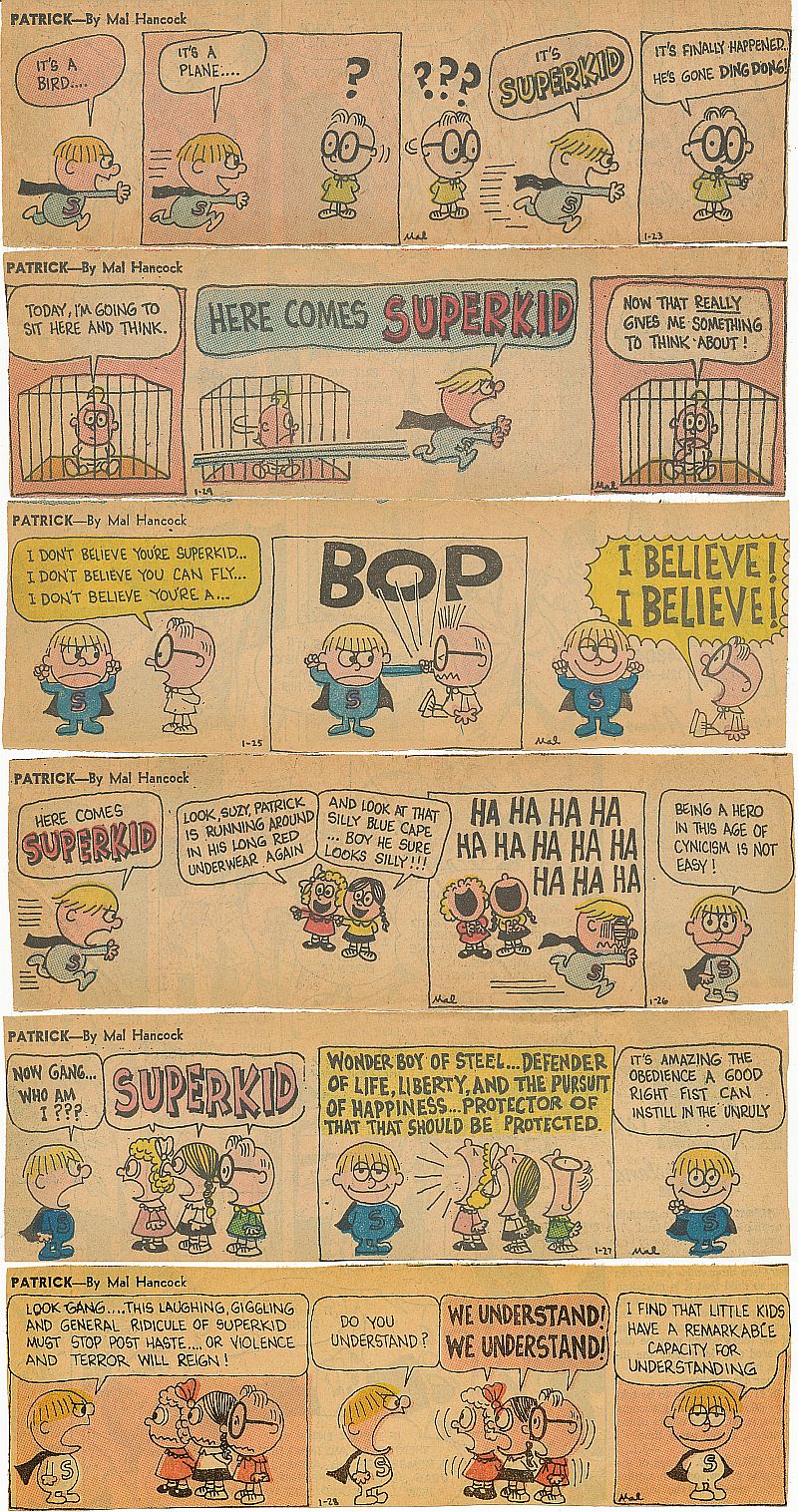  Patrick runs roughshod, or is it “supershod”, as Superkid! He lords it over Godfrey, Suzy and Elsa; his brother Nathan can’t understand what Patrick is up to. Maybe Godfrey is right, and Patrick has gone “Ding Dong”. If it hadn’t been for my brother’s unselfish efforts in clipping this strip, we wouldn’t have such nice color scans to read today. I hope the next post will be released under happier circumstances. Farewell John!
 Patrick runs roughshod, or is it “supershod”, as Superkid! He lords it over Godfrey, Suzy and Elsa; his brother Nathan can’t understand what Patrick is up to. Maybe Godfrey is right, and Patrick has gone “Ding Dong”. If it hadn’t been for my brother’s unselfish efforts in clipping this strip, we wouldn’t have such nice color scans to read today. I hope the next post will be released under happier circumstances. Farewell John!
First Post of 2012
Hi Readers, welcome to the first post this year. Barker Bill continues the “Gelt” story line from 11-29 to 12-11-1954. Gumshoe Googan, police detective, is on the job, looking for stolen money. The Gelt eats a counterfeit $50 bill, which makes him sick. Googan is so dumb that he changes five tens for one on the counterfeit fifties. More Kuwahara hi-jinks next time. All but the first two strips this time were courtesy of Yowp. Make sure you visit his blogs, “Yowp” and “Tralfaz” by clicking on the links in the blogroll.






 Â Felix, from 5-6 to 5-12-1935, continues the adventures of Danny Dooit and Felix on the tropical island. They escape from the ape, only to be attacked by a panther, an adroit design halfway between real and cartoon. The ape clobbers the panther with a coconut and they fight. I love that beautiful silhouette of Felix and Danny in the 5-8. The Sunday has Felix still stealing food from the Giant, and fending off a dog who is after Felix’s buried bone. Note that Felix has three fingered white gloves in this page. Looks like the deadly Mouse fever has hit Felix’s Dreamland.
 Felix, from 5-6 to 5-12-1935, continues the adventures of Danny Dooit and Felix on the tropical island. They escape from the ape, only to be attacked by a panther, an adroit design halfway between real and cartoon. The ape clobbers the panther with a coconut and they fight. I love that beautiful silhouette of Felix and Danny in the 5-8. The Sunday has Felix still stealing food from the Giant, and fending off a dog who is after Felix’s buried bone. Note that Felix has three fingered white gloves in this page. Looks like the deadly Mouse fever has hit Felix’s Dreamland.





 Â Krazy this time, from 3-17 to 3-22-41 tries to sort out Goose, Geese, Ganders, Drakes and Cobs, among other waterfowl. He encounters a bad tempered “Swomm” in the 3-21.
 Krazy this time, from 3-17 to 3-22-41 tries to sort out Goose, Geese, Ganders, Drakes and Cobs, among other waterfowl. He encounters a bad tempered “Swomm” in the 3-21.
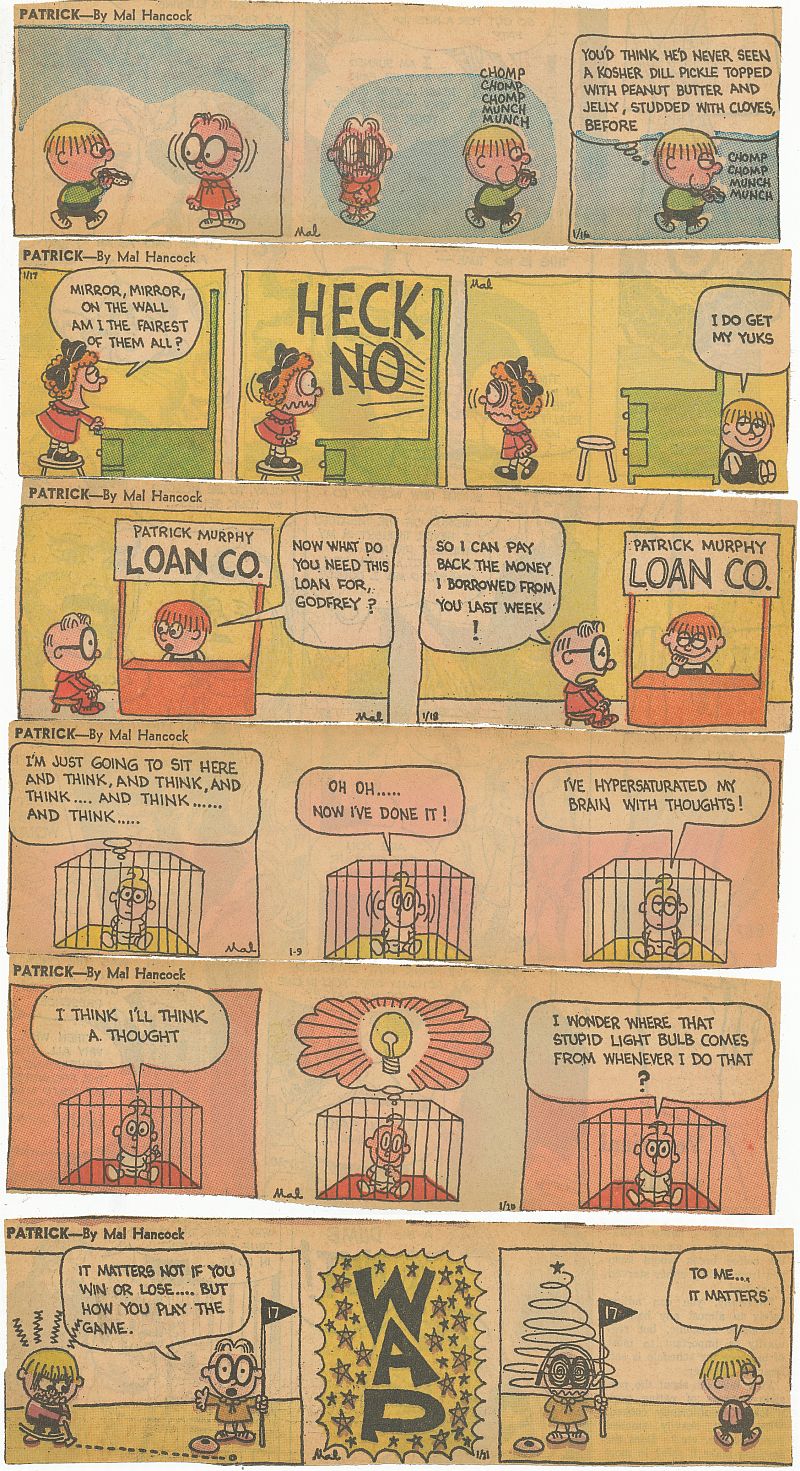 Patrick, from 1-16 to 1-21-1967, features Patrick emulating the early Charlie Brown in the 1-17, frustrating poor Elsa. Godfrey takes his usual lumps, and Nathan the baby makes fun of an icon of Comicana.
Patrick, from 1-16 to 1-21-1967, features Patrick emulating the early Charlie Brown in the 1-17, frustrating poor Elsa. Godfrey takes his usual lumps, and Nathan the baby makes fun of an icon of Comicana.


 Here come the monthly Yogi pages in imitation of Yowp’s fine example. They are from 1-7 to 1-21-1962. Go over to his blog for notes on the strips and see a black and white “tab” version of the 1-28 strip with Quick Draw McGraw as a guest character. The art on the 1-14 and 1-21 episodes and perhaps the 1-7, seem to be the work of Harvey Eisenberg. Some of my readers don’t read me too often because they don’t like to read comics on the Internet. Mike Barrier gets terrible headaches when he tries to read them. My solution, always click on the small strips to enlarge them, and get a Logitech Mouse! There is a little wheel in the center of the mouse. When you spin it, it blows up the contents of the page in front of you. You can even fill the screen with the image, which makes the artwork and inking really stand out for study. If you get this tool, maybe your head won’t hurt so bad. Thanks again to our kind suppliers, my brother Kurt, the good dog Yowp and the fine people at ProQuest newspaper archive and the Glendale Public Library. See you soon.
Here come the monthly Yogi pages in imitation of Yowp’s fine example. They are from 1-7 to 1-21-1962. Go over to his blog for notes on the strips and see a black and white “tab” version of the 1-28 strip with Quick Draw McGraw as a guest character. The art on the 1-14 and 1-21 episodes and perhaps the 1-7, seem to be the work of Harvey Eisenberg. Some of my readers don’t read me too often because they don’t like to read comics on the Internet. Mike Barrier gets terrible headaches when he tries to read them. My solution, always click on the small strips to enlarge them, and get a Logitech Mouse! There is a little wheel in the center of the mouse. When you spin it, it blows up the contents of the page in front of you. You can even fill the screen with the image, which makes the artwork and inking really stand out for study. If you get this tool, maybe your head won’t hurt so bad. Thanks again to our kind suppliers, my brother Kurt, the good dog Yowp and the fine people at ProQuest newspaper archive and the Glendale Public Library. See you soon.
Happy New Year’s Post
Happy New Year, everybody! As we ring out the old one, let’s welcome the new year with some old comic strips. Here is Barker Bill from 11-15 to Sunday, 11-28-1954. The first six dailies were sent to me by Yowp and were culled from the Winnipeg Free Press. The second batch of six dailies and the Sunday page are by courtesy of the Glendale Public Library and the ProQuest collection of the Boston Globe. Barker Bill and Puddy try to exhibit the money-eating Gelt as a circus attraction, but he literally eats up all the profits. The Sunday page from 11-28 was the earliest one that the Boston Globe carried, featuring Ironhead the Invincible. The Globe ran Barker Bill for only about 6 months and used the Sunday page infrequently, but it’s a revelation to me that Barker Bill even HAD a Sunday page. I have no idea if this is the first Sunday or not, perhaps one of my readers can fill us in.
Felix (from 4-29 to 5-5-1935) continues the “Ape” saga, as Danny notices that Felix has been catnapped and pursues the Ape to the island, only to be caught himself. The Sunday page continues the adventures of Felix in Dreamland, using lots of cherce puns as Felix uses doughnuts and playing cards (“When it comes to gliding, I’m an ace!”) to elude the Giant. I like the gag in the “Laura” topper as the hapless parrot sings “I Cover the Waterfront” to a corpulent lady bather.
In Krazy (3-10 to 3-15-1941) the handsome Don Jose Kiyoti cuts a wide swath through the women of Coconino. He flirts with Krazy, Mrs. Ignatz Mouse and Mimi, the Poodle. The Don hides under Mimi’s table in the 3-15, after all, she’s the lady nearest in size to the “Dawn”.
In Patrick (1-9 to 1-15-1967), Elsa predicts the future in the 1-11 strip. Ronald Reagan became the Governor of California in 1966, and won the Presidency in 1980. It might have seemed silly and funny that a little star-struck girl was wowed by a MOVIE STAR as Governor in 1967, but she was certainly accurate in anticipating what would happen to that STAR. In the 1-15, we have the first appearance of Patrick’s alter ego: “Superkid”. Over the next few months, you’ll see Patrick use and abuse that alias. A little side note, I was attending the Kansas City Art Institute in 1967 and had no access to the St. Louis Post-Dispatch, so my “kid brother”, Kurt, was kind enough to clip these strips for me, and ultimately, you! We all owe him big time. It’s been another year of hopes and delayed hopes, let’s give several Elmer Blurt imitations for 2012. See you then.
The Christmas Post 2011
  Merry Christmas, Happy Chanukah to all my readers! The record cover pictured here is one of those childhood memories that refuse to leave the brain. The song “Practice Makes Perfect”, on side two, sung by Bil Baird as The Dooley, pops into my mind almost every week, mostly unbidden. If you listen to the record: www.archive.org/details/TheWhistlingWizardGoldenRecord, you will hear Practice Makes Perfect about half-way in, the record runs six minutes. Please excuse the hum in the background, as this was recorded off Cathy’s old turntable at 78RPM. My mother must have bought this record for me when I was two or three years old. She probably sang “Practice Makes Perfect” along with the record to encourage me to practice the piano. In those days I had a little 78 phonograph that was shaped like a tall cylinder with stars on the side of it, and with a rather large tone arm that probably damaged the records as I played them. I loved repetition, and literally played most of my records to death. Thanks to Ebay, I found a beat-up, but still playable copy, and the memories came flooding back. I remembered “Practice Makes Perfect” as a lot more shrill and silly than it is here, but the melody and most of the lyrics are the same as I remember. The shrill overtones that I thought were on there might have come from the tinny little amplifier of the old Star sided record player. “The Whistling Wizard” was one of the few Big Golden Records releases, most Golden Records were little. It featured the cast of the first color television series, broadcast on CBS in 1951. The color system used, “field sequential”, was cumbersome and ultimately not adopted for regular telecasts. There don’t seem to be any kinescopes available of the show, certainly none in color, and I can’t remember if I ever saw it broadcast or not. I loved Bil Baird’s marionette and hand puppet designs, especially Heathcliff the horse and Charlemagne, the lion. Charlemagne later on morphed into Champy the Lion, who starred on the old Wheaties TV commercials from 1956. Baird’s puppets looked like a combination of Tony Sarg (Bil’s mentor) and Eastern European puppet design. Baird’s first show before “Wizard”, was “Life With Snarky Parker” directed by Yul Brynner. Heathcliff the talking horse was a holdover from Snarky’s show. Baird was a big deal on TV in the mid-1950s before the puppet world was eclipsed by Jim Henson’s Muppet designs. Baird did a couple of specials with Art Carney, one of which was “Art Carney Meets Peter and the Wolf”. Copies are available of that one, and the marionette work was impressive, especially the wolf. Carney really entered the spirit of the story and made the puppets seem even more alive by his very warm relationship with them. Look around on You Tube for it.
 Merry Christmas, Happy Chanukah to all my readers! The record cover pictured here is one of those childhood memories that refuse to leave the brain. The song “Practice Makes Perfect”, on side two, sung by Bil Baird as The Dooley, pops into my mind almost every week, mostly unbidden. If you listen to the record: www.archive.org/details/TheWhistlingWizardGoldenRecord, you will hear Practice Makes Perfect about half-way in, the record runs six minutes. Please excuse the hum in the background, as this was recorded off Cathy’s old turntable at 78RPM. My mother must have bought this record for me when I was two or three years old. She probably sang “Practice Makes Perfect” along with the record to encourage me to practice the piano. In those days I had a little 78 phonograph that was shaped like a tall cylinder with stars on the side of it, and with a rather large tone arm that probably damaged the records as I played them. I loved repetition, and literally played most of my records to death. Thanks to Ebay, I found a beat-up, but still playable copy, and the memories came flooding back. I remembered “Practice Makes Perfect” as a lot more shrill and silly than it is here, but the melody and most of the lyrics are the same as I remember. The shrill overtones that I thought were on there might have come from the tinny little amplifier of the old Star sided record player. “The Whistling Wizard” was one of the few Big Golden Records releases, most Golden Records were little. It featured the cast of the first color television series, broadcast on CBS in 1951. The color system used, “field sequential”, was cumbersome and ultimately not adopted for regular telecasts. There don’t seem to be any kinescopes available of the show, certainly none in color, and I can’t remember if I ever saw it broadcast or not. I loved Bil Baird’s marionette and hand puppet designs, especially Heathcliff the horse and Charlemagne, the lion. Charlemagne later on morphed into Champy the Lion, who starred on the old Wheaties TV commercials from 1956. Baird’s puppets looked like a combination of Tony Sarg (Bil’s mentor) and Eastern European puppet design. Baird’s first show before “Wizard”, was “Life With Snarky Parker” directed by Yul Brynner. Heathcliff the talking horse was a holdover from Snarky’s show. Baird was a big deal on TV in the mid-1950s before the puppet world was eclipsed by Jim Henson’s Muppet designs. Baird did a couple of specials with Art Carney, one of which was “Art Carney Meets Peter and the Wolf”. Copies are available of that one, and the marionette work was impressive, especially the wolf. Carney really entered the spirit of the story and made the puppets seem even more alive by his very warm relationship with them. Look around on You Tube for it.
A while ago, I experimented with reading Dorothy Parker and other stories aloud, and making them available on the blog. They weren’t too popular, maybe I’m not much of a reader, but here’s a “Christmas Leftover” that I’m handing out, Chapter 24 of Felix Salten’s “Bambi”. In Salten’s original, Bambi does not live happily ever after with Faline, and the old Stag is almost at the end of his life. Bambi’s father takes Bambi to a lonely place in the forest where a man has died as the result of a shooting accident. As he observes the bleeding corpse, Bambi learns that man is not all-powerful, as many of the animals believed, but vulnerable, and capable of being killed like all the other creatures of Earth. This idea isn’t featured in the Disney cartoon; Salten’s story is quite a lot darker. If you care to hear me read it: www.archive.org/details/BambiChapter24ReadByMarkKausler. Click over to Archive.org and listen. It runs 7.40Â minutes or so.











 Â Barker Bill from 11-1 to 11-13-1954, comes to us by courtesy of Yowp, remember to click on the Blogroll to your right to access his two fine blogs, Yowp and Tralfaz. Bill discovers the Gelt from the African Veldt in the beginning of the story that I started two posts ago with greatly inferior copies of the strips. The missing episodes are now filled in, and we will continue the money-eating Gelt’s adventures next post.
 Barker Bill from 11-1 to 11-13-1954, comes to us by courtesy of Yowp, remember to click on the Blogroll to your right to access his two fine blogs, Yowp and Tralfaz. Bill discovers the Gelt from the African Veldt in the beginning of the story that I started two posts ago with greatly inferior copies of the strips. The missing episodes are now filled in, and we will continue the money-eating Gelt’s adventures next post.






 Â Felix, from 4-22 to 4-28-1935, is hauled away to the Ape’s den. Felix makes his escape from the den, and is picked up by Danny and the ship’s crew. In a silhouette panel that reminds me of the movie “King Kong”, the Ape sneaks aboard ship in the 4-27, and takes Felix to his den once more. In the Sunday, Felix is still in Dreamland, and escapes from the Giant by bouncing away with the help of the eraser end of a giant pencil!
 Felix, from 4-22 to 4-28-1935, is hauled away to the Ape’s den. Felix makes his escape from the den, and is picked up by Danny and the ship’s crew. In a silhouette panel that reminds me of the movie “King Kong”, the Ape sneaks aboard ship in the 4-27, and takes Felix to his den once more. In the Sunday, Felix is still in Dreamland, and escapes from the Giant by bouncing away with the help of the eraser end of a giant pencil!





  Krazy, from 3-3 to 3-8-41, features one storyline for the week: “The Duel”. Don Kiyoti encourages Offissa Pupp to fight a duel with Ignatz after Ignatz defiantly snaps his fingers at the Pupp. Don Kiyoti serves as Pupp’s second and Ignatz’s wife and kids serve as the Mouse’s seconds, thirds, fourths and fifths. The duel ends in a brick toss which misses Offissa Pupp and hits….should I tell you?
 Krazy, from 3-3 to 3-8-41, features one storyline for the week: “The Duel”. Don Kiyoti encourages Offissa Pupp to fight a duel with Ignatz after Ignatz defiantly snaps his fingers at the Pupp. Don Kiyoti serves as Pupp’s second and Ignatz’s wife and kids serve as the Mouse’s seconds, thirds, fourths and fifths. The duel ends in a brick toss which misses Offissa Pupp and hits….should I tell you?
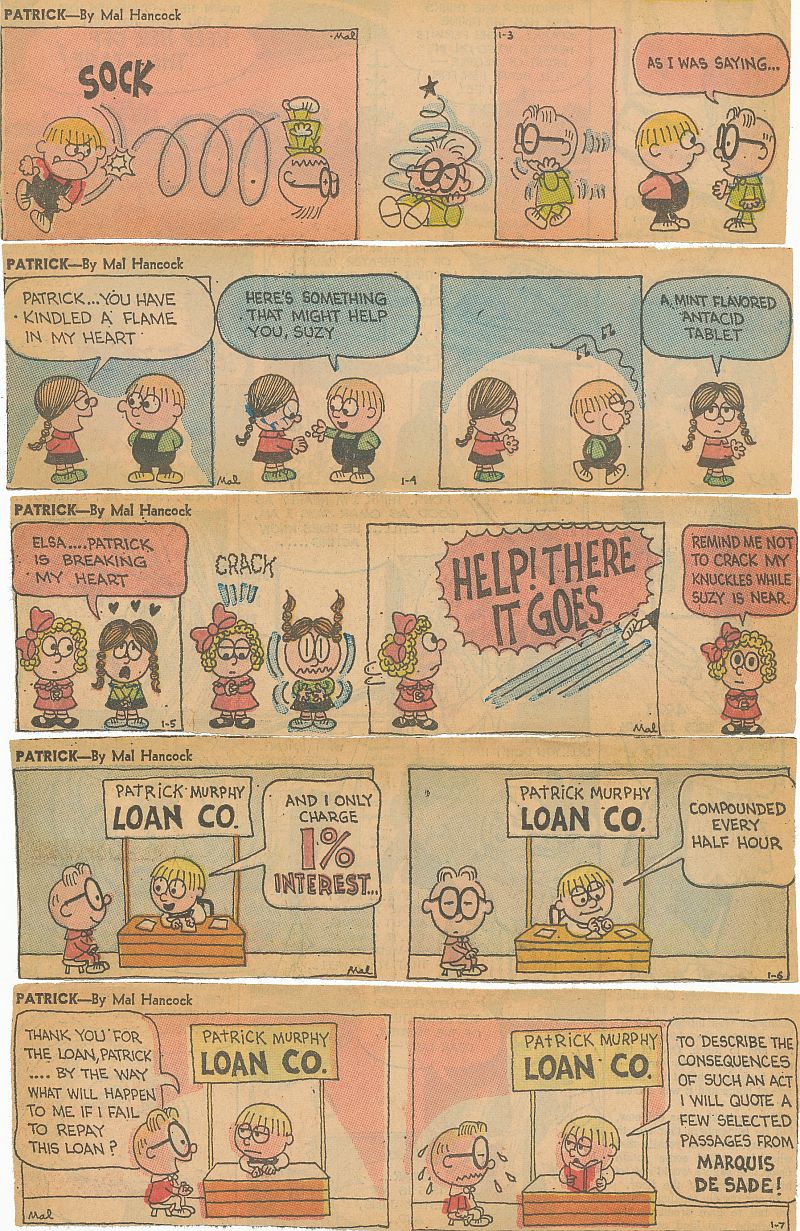 Â Patrick, from 1-3 to 1-7-1967, really has a Schulz flavor this time. Elsa and Suzie’s antics in the 1-5 remind me of Violet and Patty, if a bit more manic, and Patrick’s loan company reminds me of Lucy’s Psychiatry Booth, and even more of Skippy’s various businesses in the 1930s. I don’t remember if Skippy threatened Marquis de Sade tactics on his clients, but maybe Percy Crosby didn’t think Skippy should be that precocious. Stay away from undercooked Christmas Goose folks, and recycle your wrapping paper. We’ll see you again after Ol’ Sam Nicholas has returned to the Toy Factory.
 Patrick, from 1-3 to 1-7-1967, really has a Schulz flavor this time. Elsa and Suzie’s antics in the 1-5 remind me of Violet and Patty, if a bit more manic, and Patrick’s loan company reminds me of Lucy’s Psychiatry Booth, and even more of Skippy’s various businesses in the 1930s. I don’t remember if Skippy threatened Marquis de Sade tactics on his clients, but maybe Percy Crosby didn’t think Skippy should be that precocious. Stay away from undercooked Christmas Goose folks, and recycle your wrapping paper. We’ll see you again after Ol’ Sam Nicholas has returned to the Toy Factory.
More “Barkers” From Yowp











  Thanks to Yowp, who downloaded these strips, here are the Barker Bill dailies from 10-18 to 10-30-1954. In the last blog post, during the 10-8-54 strip, Barker Bill  speculated about Dog Biscuit’s resemblance to a TV personality. That would have to be Dave Garroway, who was known for his big smile and dark, horn rimmed glasses. Dave was the host of NBC’s Today show from 1954 to 1961, so this would have been during his heyday. In these strips, Dog Biscuit the horse, breaks his glasses and loses the race, upping the odds on Glue Foot, the slowest horse. Glue Foot wins, and “Longshot Louie” pays off to Barker Bill!
 Thanks to Yowp, who downloaded these strips, here are the Barker Bill dailies from 10-18 to 10-30-1954. In the last blog post, during the 10-8-54 strip, Barker Bill  speculated about Dog Biscuit’s resemblance to a TV personality. That would have to be Dave Garroway, who was known for his big smile and dark, horn rimmed glasses. Dave was the host of NBC’s Today show from 1954 to 1961, so this would have been during his heyday. In these strips, Dog Biscuit the horse, breaks his glasses and loses the race, upping the odds on Glue Foot, the slowest horse. Glue Foot wins, and “Longshot Louie” pays off to Barker Bill!






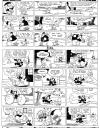 Â Felix, from 4-15 to 4-21-1935 continues his adventures on the tropical island. Felix has to babysit the big ape’s little ones, but the ship is not far behind and spots birds flying toward the island. Will Felix be rescued? In the Sunday, Felix continues to stick to Dreamland, and rescues a little fly with the help of the Giant’s glasses.
 Felix, from 4-15 to 4-21-1935 continues his adventures on the tropical island. Felix has to babysit the big ape’s little ones, but the ship is not far behind and spots birds flying toward the island. Will Felix be rescued? In the Sunday, Felix continues to stick to Dreamland, and rescues a little fly with the help of the Giant’s glasses.





 Â In the strips from 2-24 to 2-19-1941, Krazy casts his bread upon the waters, and Ignatz gets away with a brick toss during Offissa Pupp’s “see no evil” routine. Ignatz spends time in Jail and razzes Pupp in the 2-29.
 In the strips from 2-24 to 2-19-1941, Krazy casts his bread upon the waters, and Ignatz gets away with a brick toss during Offissa Pupp’s “see no evil” routine. Ignatz spends time in Jail and razzes Pupp in the 2-29.
Scanned off my collection of clipped Yogi Sunday pages from the St. Louis Post Dispatch, are the December, 1961 strips. Go over to Yowp’s website and read his notes on them, then kindly come back here, click to enlarge, and read them in color and mostly half-page size (the 12-3 is only third-page).
Patrick this time, finishes off the strips from 1966, 12-27 to 12-31. Nathan is going stir crazy, and Patrick tricks Godfrey out of a dime at the same time that Godfrey tries to collect $10.53 from Patrick. Patrick promises that Godfrey’s new year will be as miserable as 1966 was in the 12-31. The Post-Dispatch did not publish on Jan. 1st, 1967, so the next Patricks will start with the 1-3-67. I hope to do a special Christmas post next time.
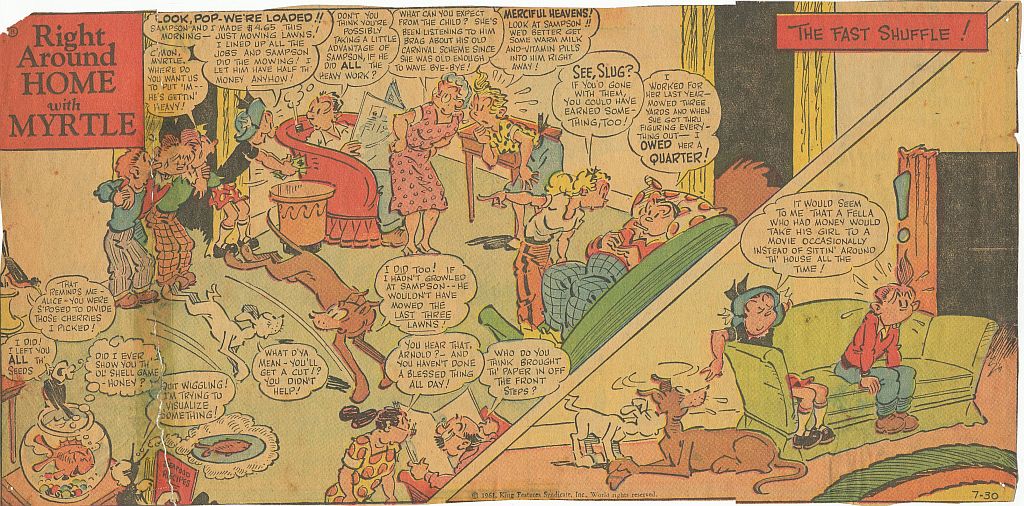
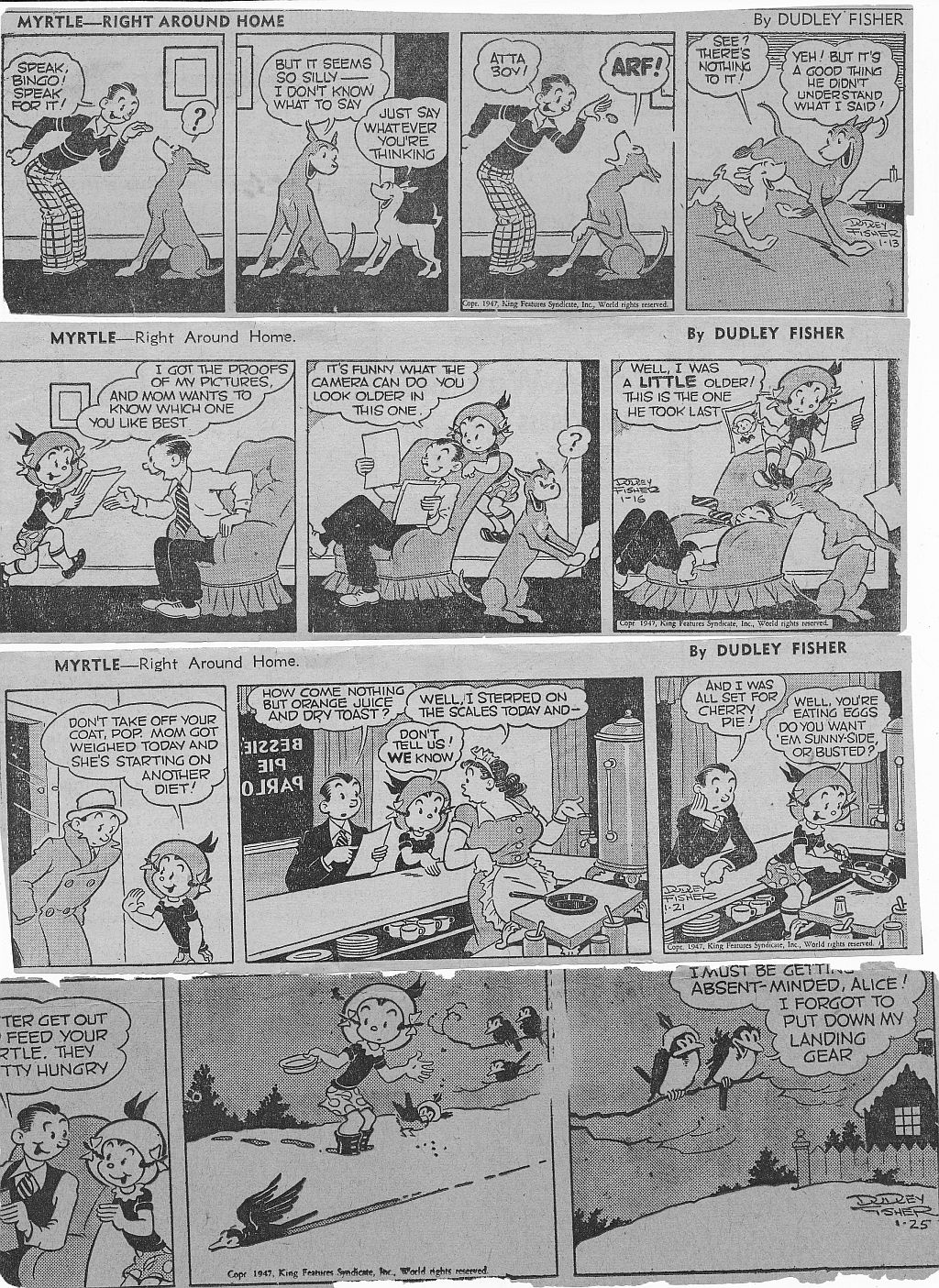




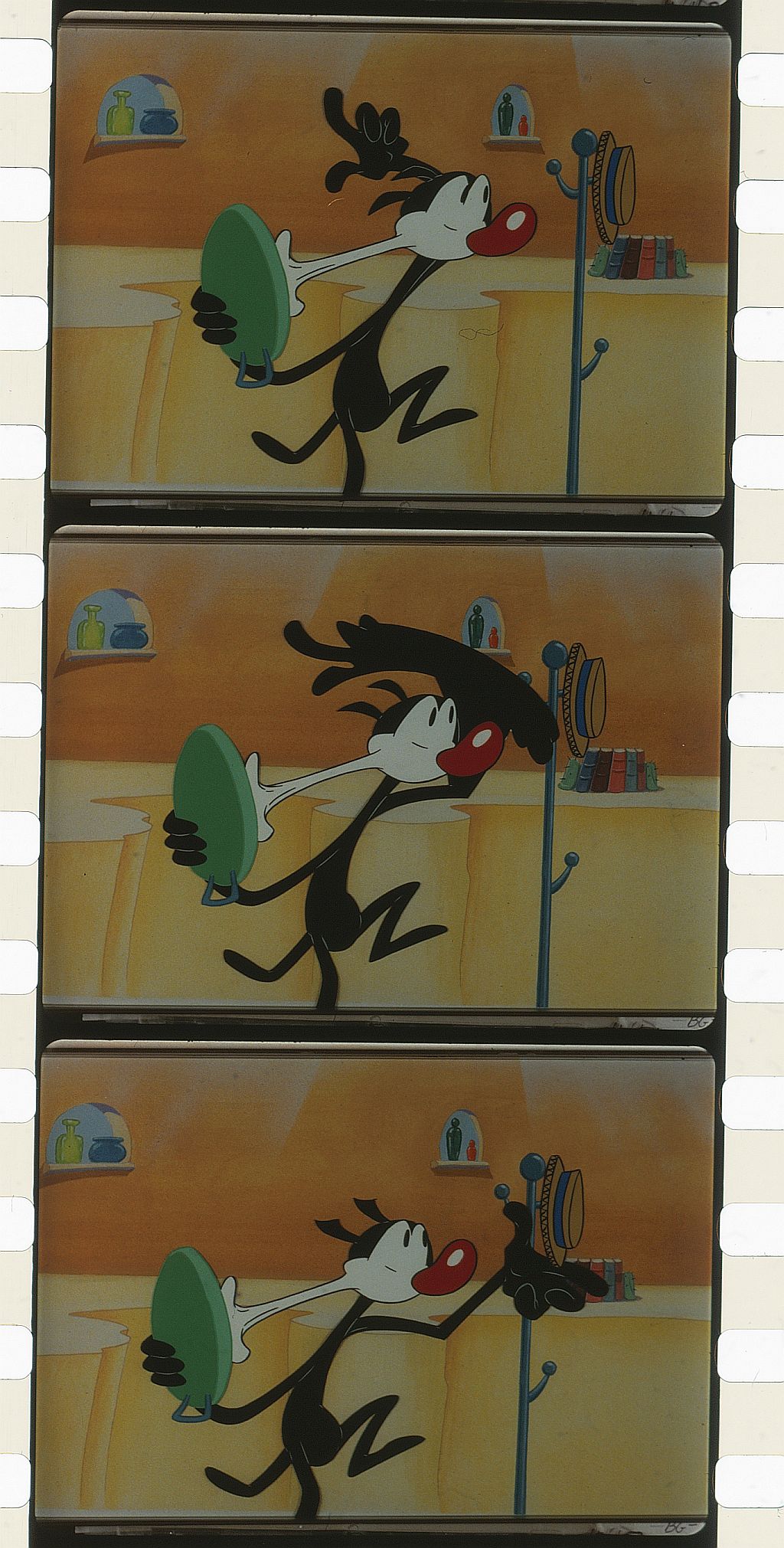
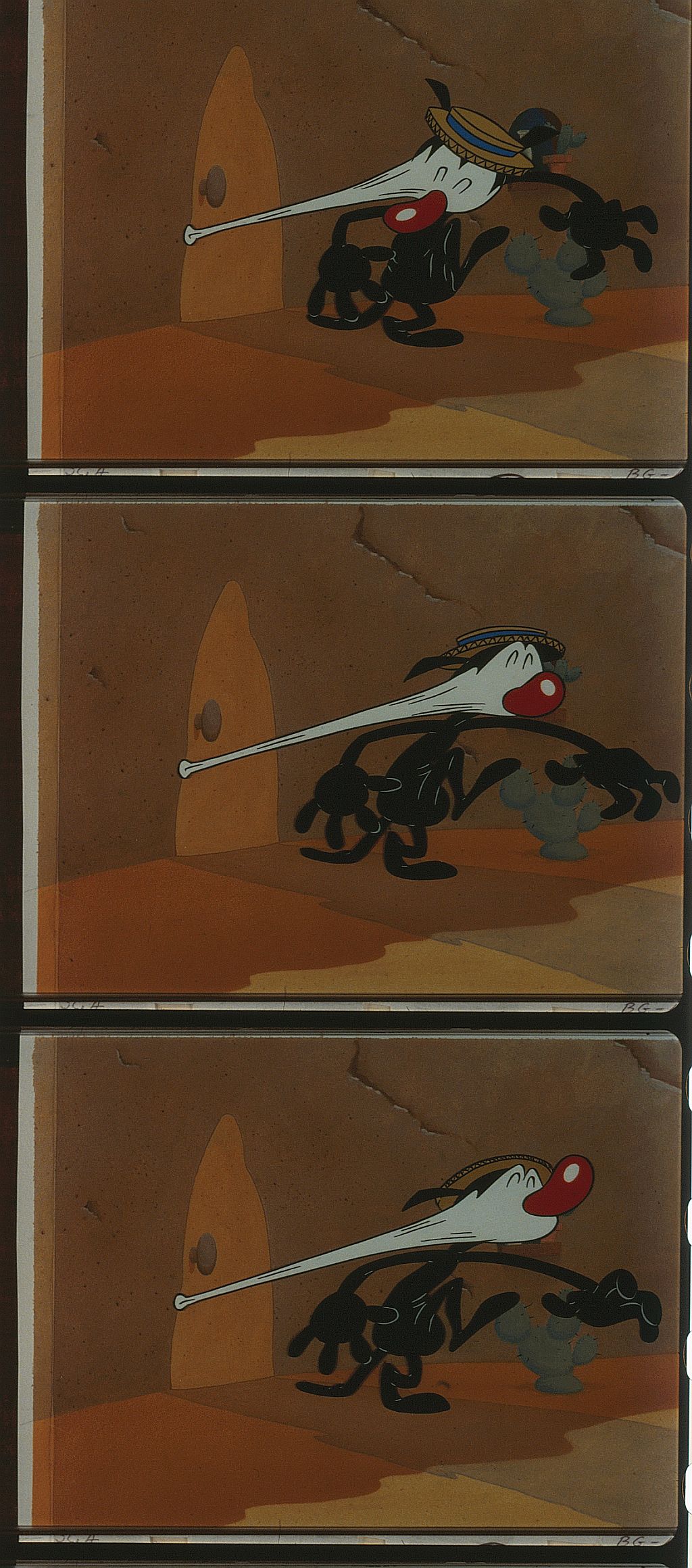
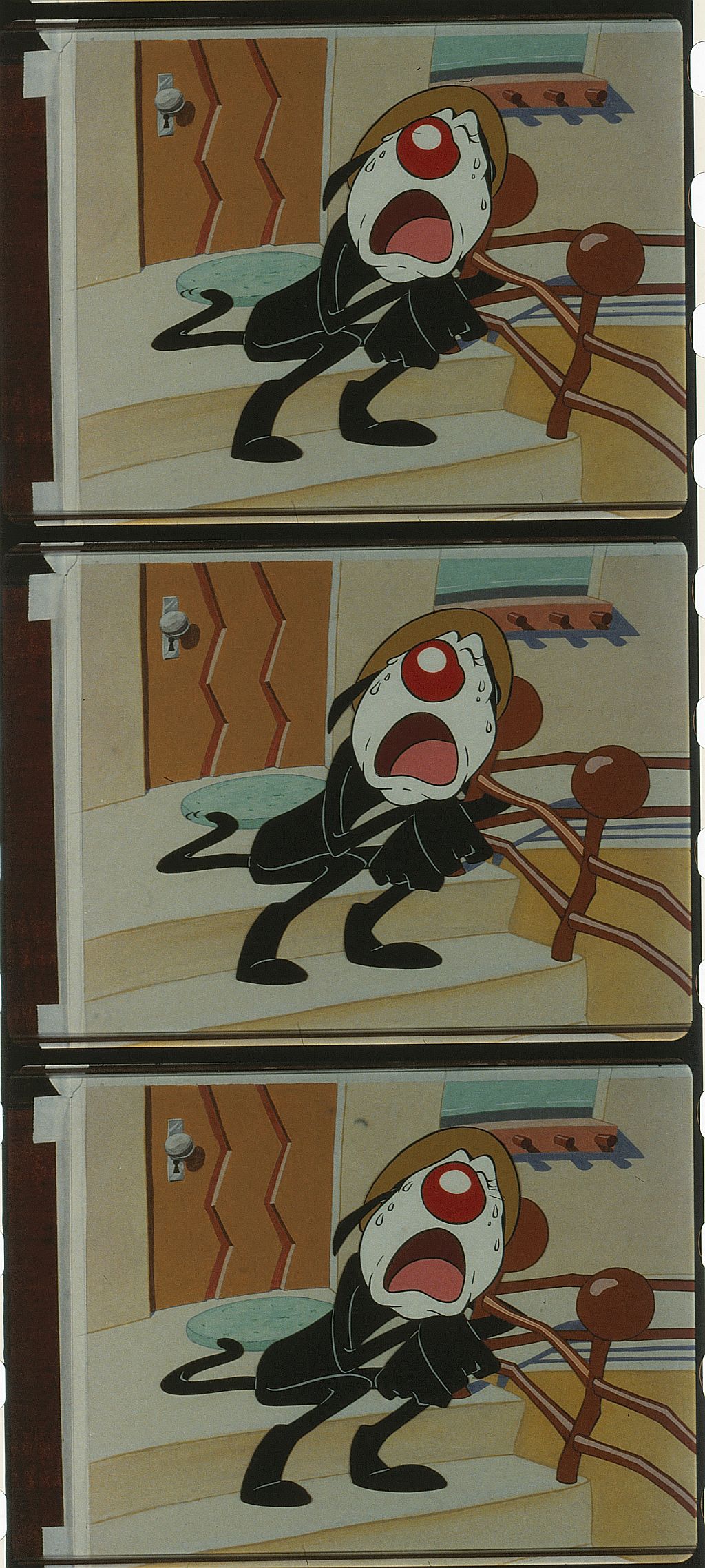
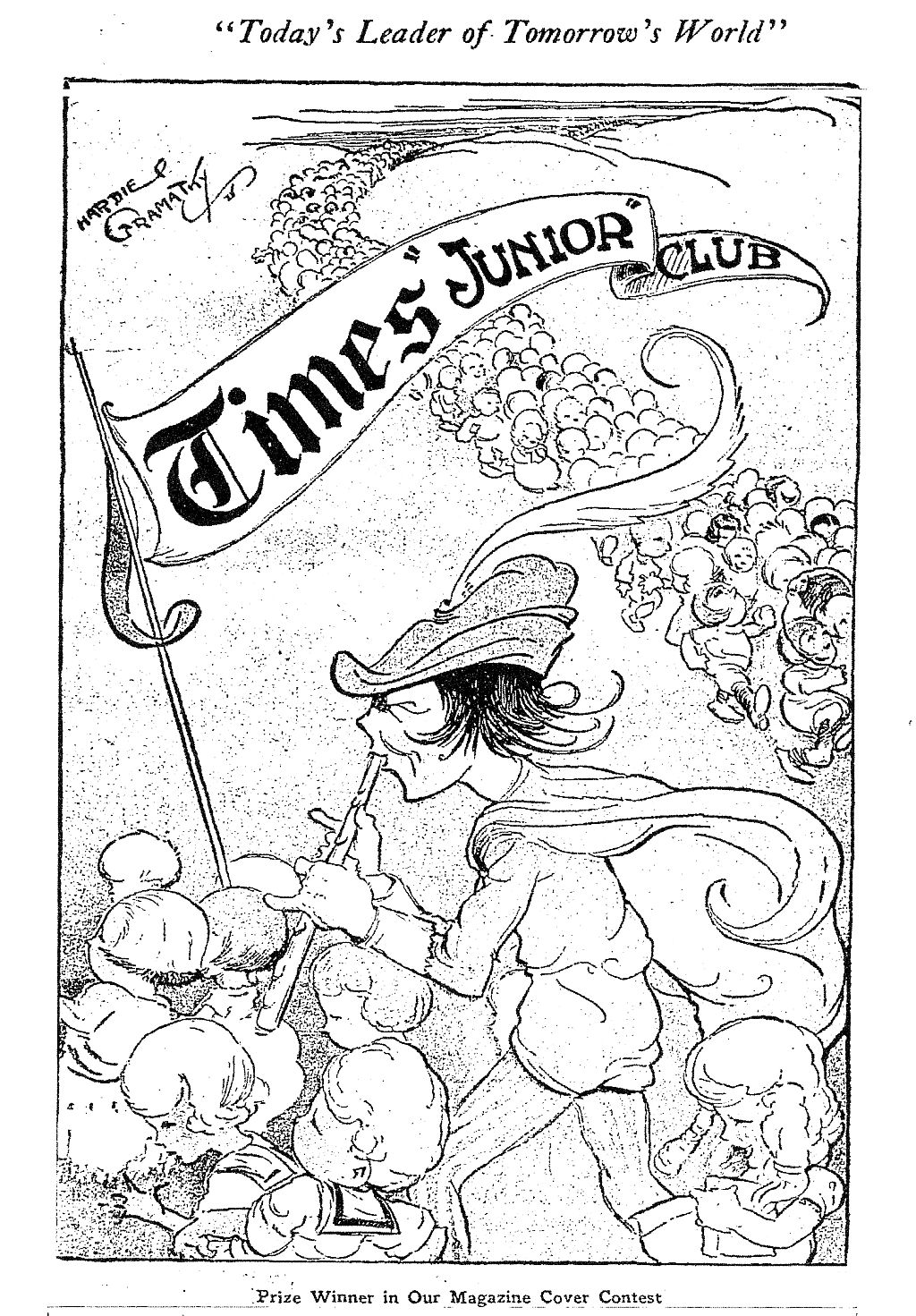

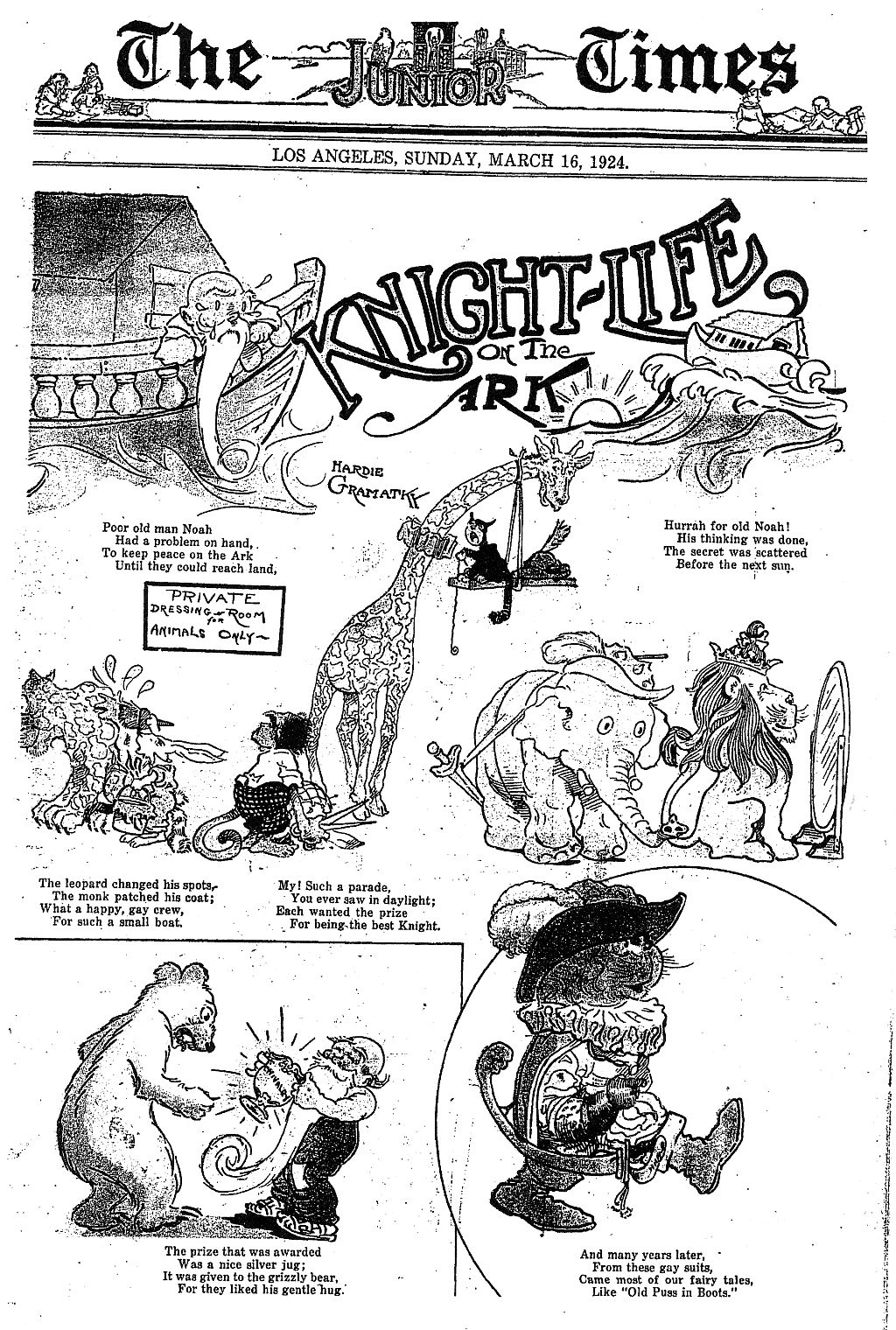


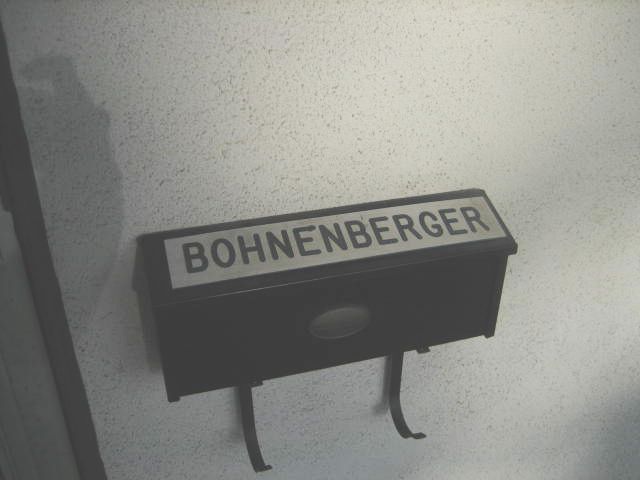
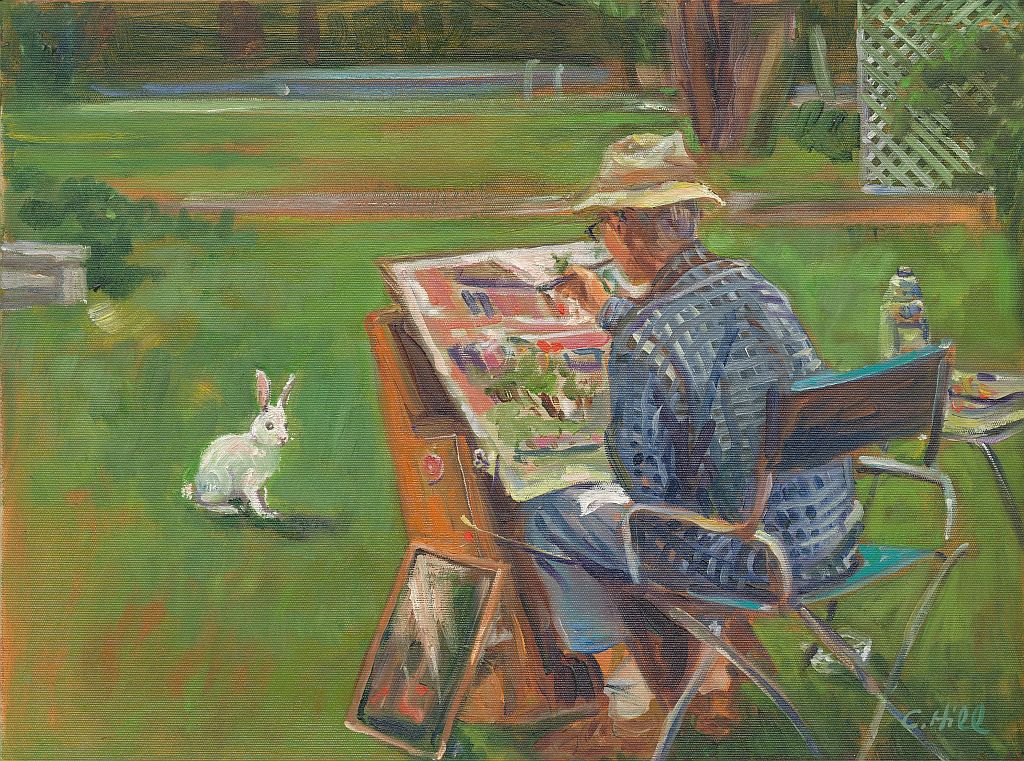
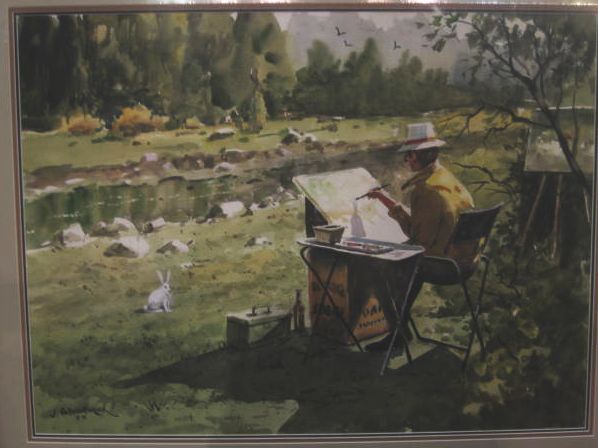

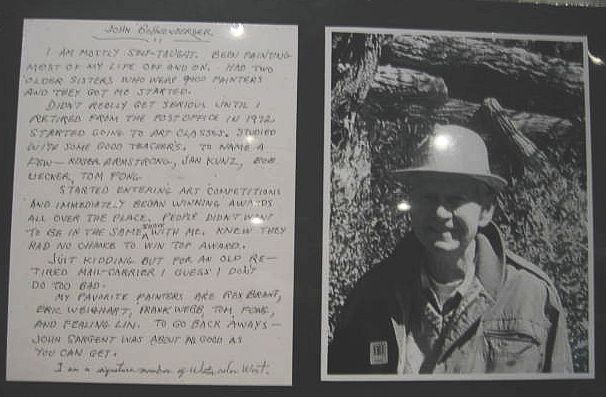































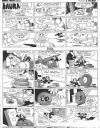






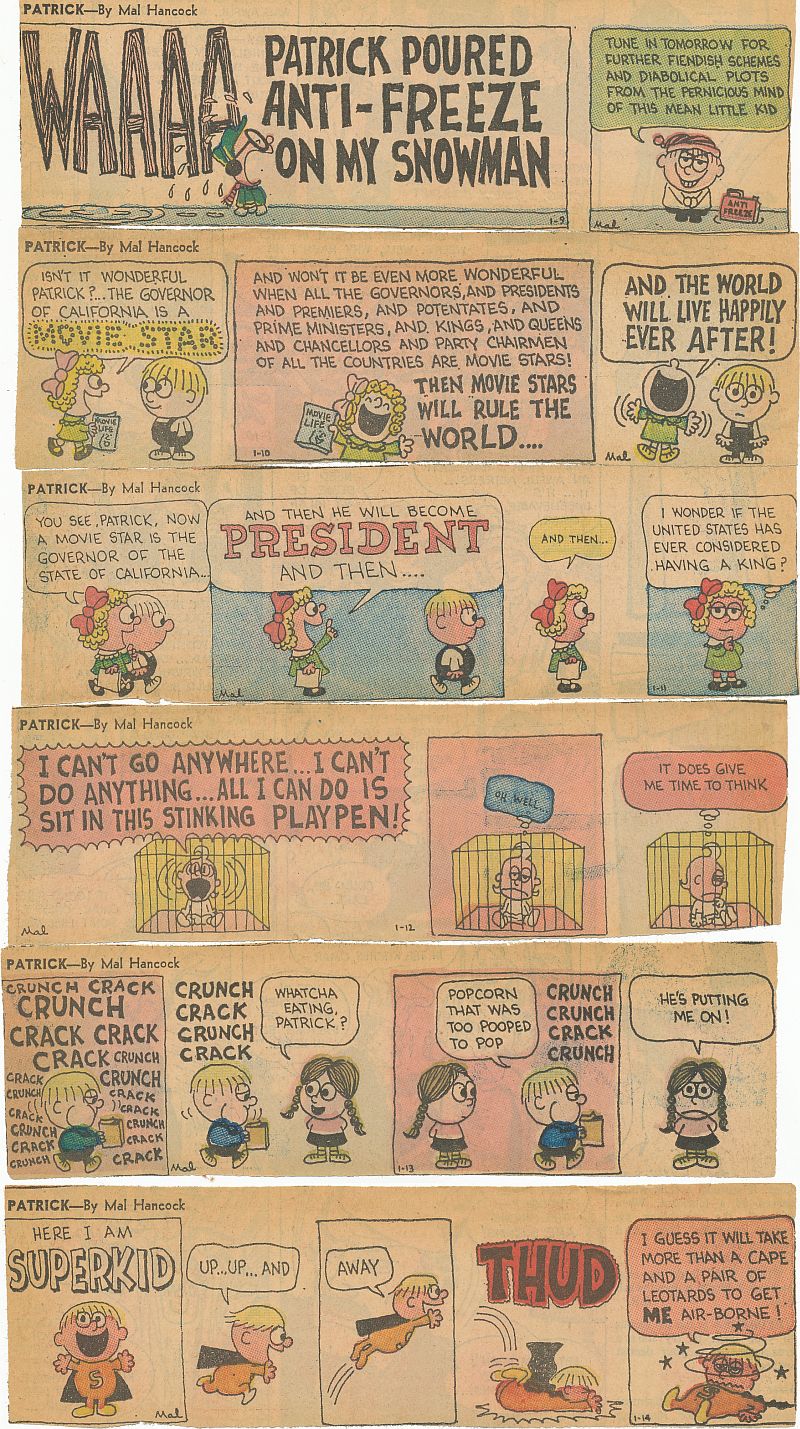





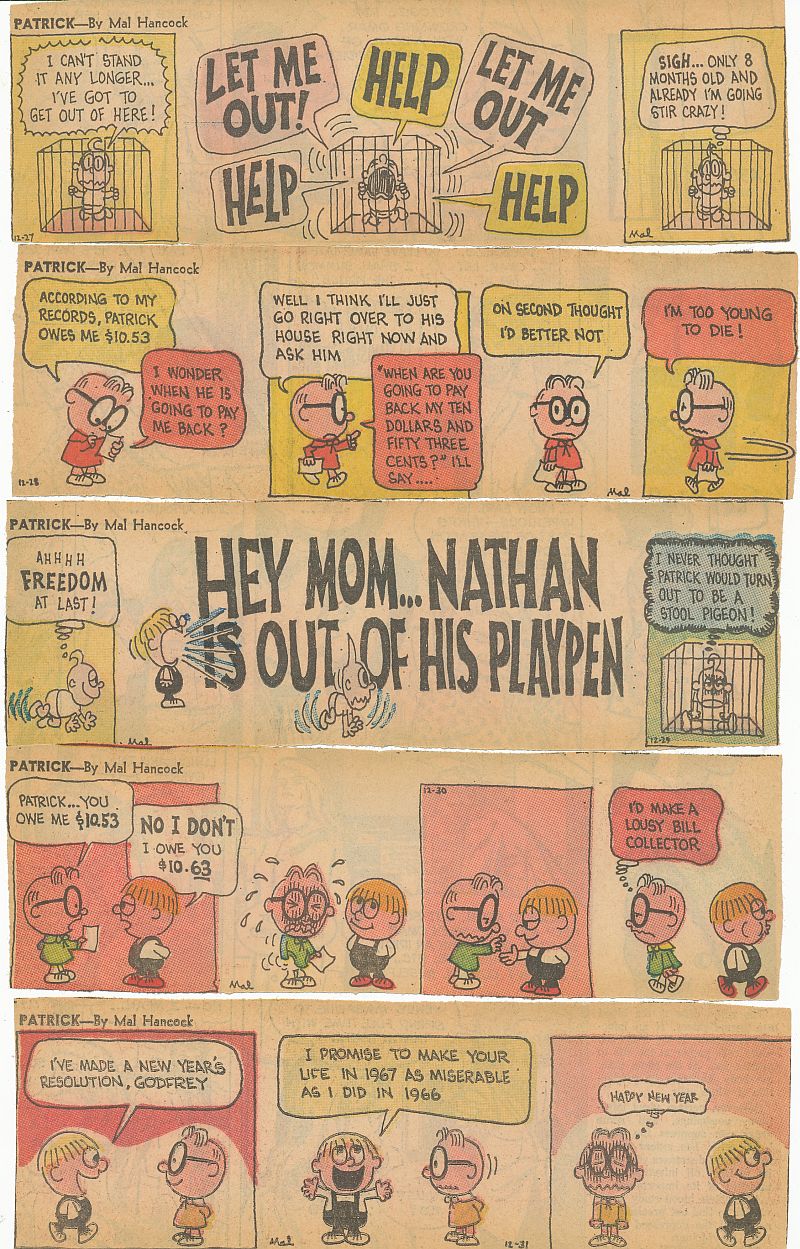
Bob, Fred and Wick in the Jr. Times
May 20, 2012
Uncategorized
4 Comments
Mark
Here’s another small survey of the L.A. Jr. Times and the future animators of America! May of 1926 was Bob Clampett’s greatest month in the Jr. Times. “The Innocent Pussy” was the ten dollar cover winner of May 16th. It really captures the innocent and mischievous spirit of a cat, like I tried to do in the animated cartoon “It’s ‘The Cat'”. I’d like to think that Bob C. would have liked my cartoon. There’s also a photograph of Bob at the age of 12 when he lived in Glendale, a poem he wrote for the Jr. Times on the virtues of the T.J.C. and one of his rare comic strips featuring the “Duke” (monocle) and “Kewp” (Derby hat) in a swimming race from Santa Monica to Ocean Park. Note that this strip foreshadows the story in “Porky’s Naughty Nephew” (babies are funny) where all the cartoon animals have a race across the lake, and Pinkie scares the wits out of them with a phony shark fin. He scares Porky into winning the race, like Duke and Kewp are frightened into swimming like two Buster Crabbes by a real shark. In “Porky’s Naughty Nephew”, a real shark gets into the act at the end of the picture, made even more ludicrous by appearing in a fresh water lake. The germ of the ideas was there in 1926! Also we have a strip (4-25-26) from future Clampett animator Larry Martin (and the model for Dishonest John), and Fred Moore, shamelessly promoting the T.J.C. in a cartoon published 4-4-26. I wonder if Bob Clampett and Fred Moore knew each other, and how did they get along at those Aunt Dolly meetings with the live jazz bands? Also we have the earliest comic strips by Bob Wickersham, a future Disney animator and key artist of the “Fox and Crow” cartoons and comic books for D.C.. He breaks precedent by working with an animal character, Fido Bark (5-9 and 5-16-26), who starts out promoting the T.J.C. (surefire for getting Aunt Dolly’s approval) and then starts doing father and son gags that remind me of “Smitty” or “Skippy”. Actually, “The Innocent Pussy”, the photo and the poem are already on the Internet, but I wanted to show them here, especially with the cat tie-in.
In Barker Bill, from 5-2 to 5-14-1955, Bill solves the Hippo mystery (the hippo coughs up the radium watch), and starts a new story line as Ali K. Zam, the circus treasurer, practices the old levitation trick and makes Barker Bill float away with Puddy on his chest. Ali can’t get Barker Bill back down to Earth without buying the counter-spell, which he can’t afford (what do you expect from a character who wears a shoe on his head?). Bill floats by the offices of Bitten, Button, Bursten and Foghorne (parody of Batten, Barton, Durstine and Osborn advertising agency), and the execs think that Bill’s floating girth would be a great place to advertise Dunker’s Donuts. They wind up tying a banner to Bill’s feet, and he’s off to make some money to buy an antidote to Ali’s levitation spell.